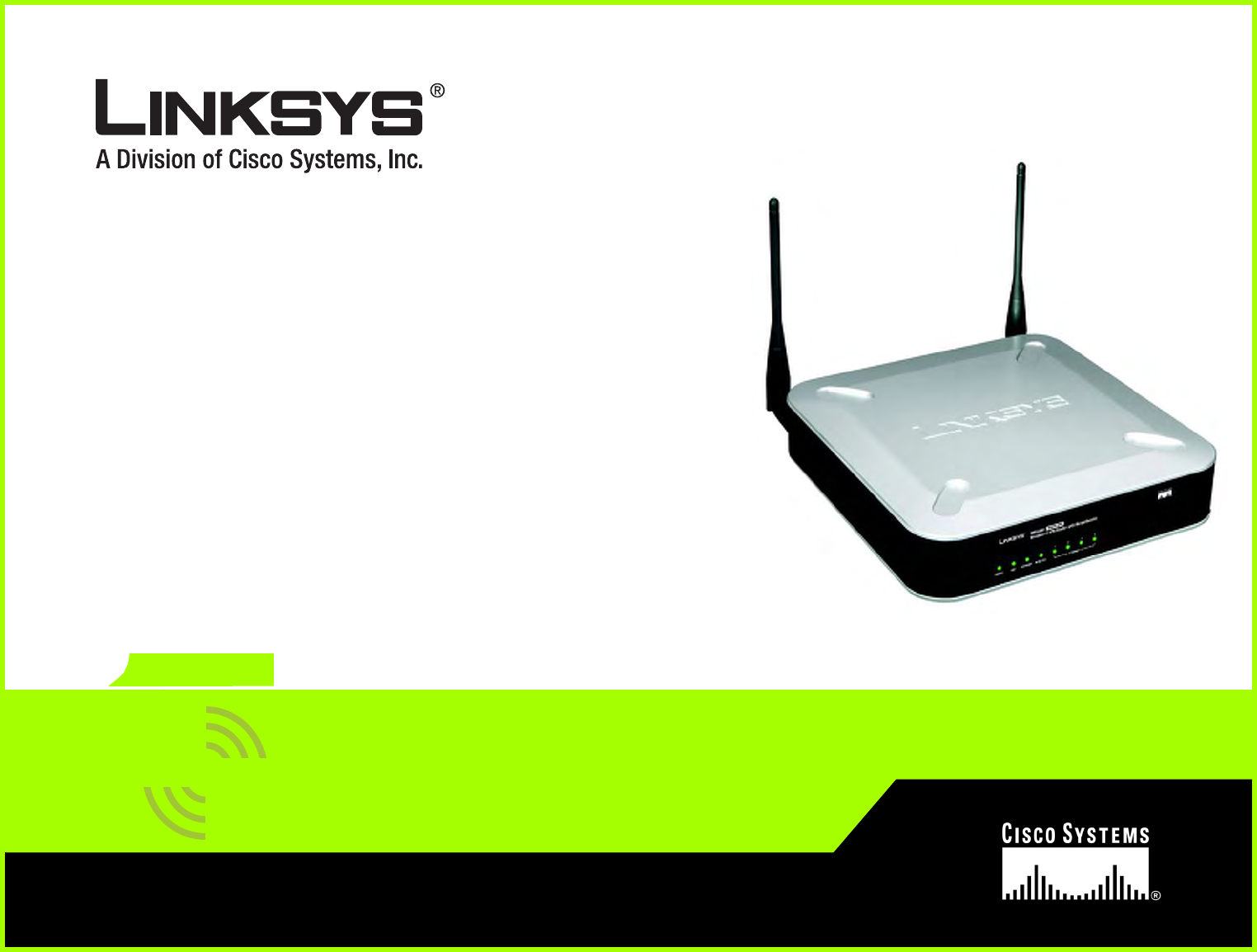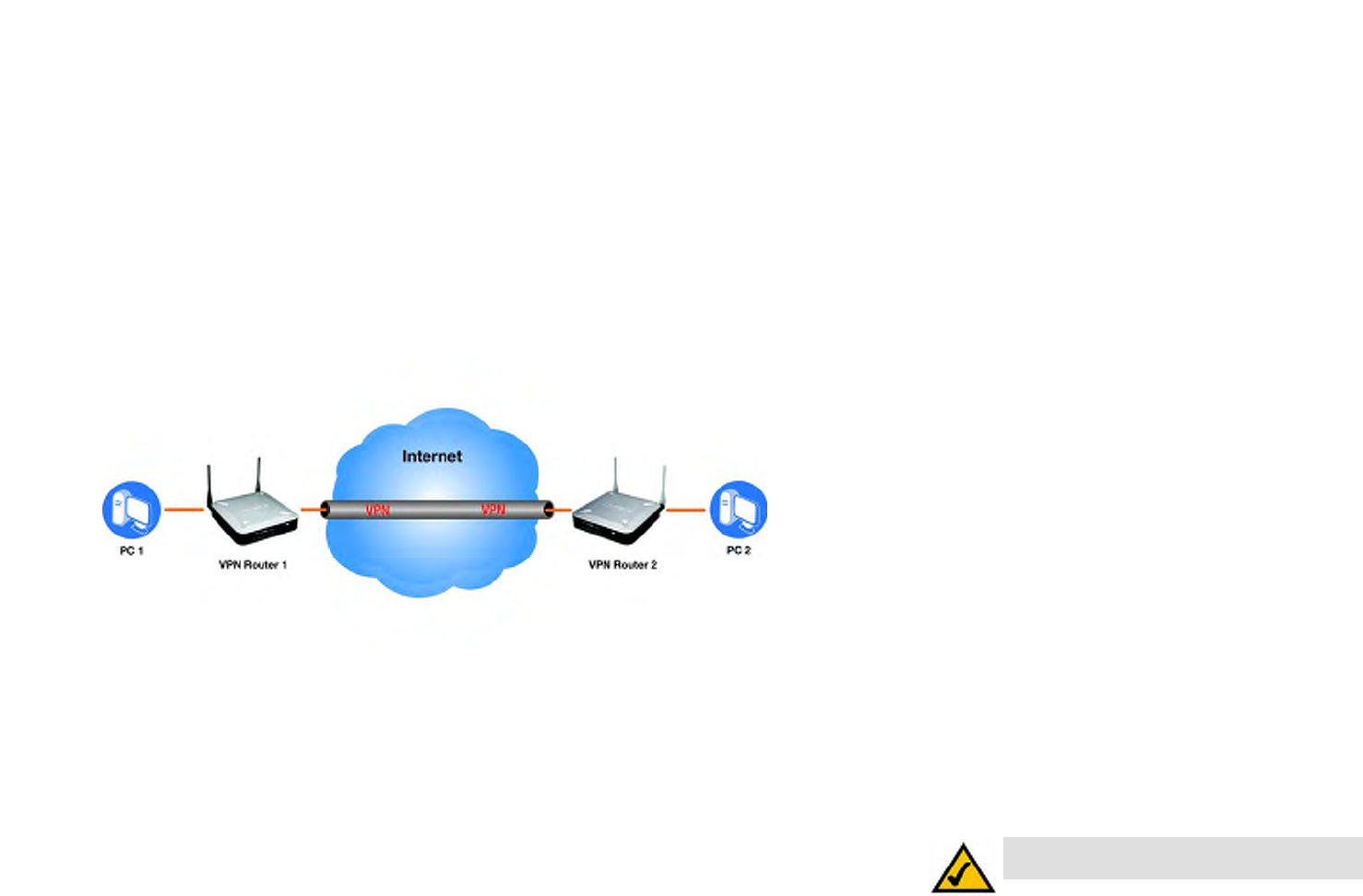LINKSYS WRV210 Wireless-G VPN Router with RangeBooster User Manual Book
LINKSYS LLC Wireless-G VPN Router with RangeBooster Book
LINKSYS >
Contents
- 1. Manual 1
- 2. Manual 2
Manual 1

Model No.
VPN Router with RangeBooster
Wireless-G
WRV210
WIRELESS
GHz
2.4
802.11g
User Guide

Wireless-G VPN Router with RangeBooster
Copyright and Trademarks
Specifications are subject to change without notice. Linksys is a registered trademark or trademark of Cisco
Systems, Inc. and/or its affiliates in the U.S. and certain other countries. Copyright © 2006 Cisco Systems, Inc. All
rights reserved. Other brands and product names are trademarks or registered trademarks of their respective
holders.
How to Use this Guide
This User Guide has been designed to make understanding networking with the Router easier than ever. Look for
the following items when reading this User Guide:
In addition to these symbols, there are definitions for technical terms that are presented like this:
Also, each figure (diagram, screenshot, or other image) is provided with a figure number and description, like
this:
Figure numbers and descriptions can also be found in the “List of Figures” section in the “Table of Contents”.
WRV210-UG-60407NC BW
This exclamation point means there is a caution or warning and is something
that could damage your property or the Router.
This checkmark means there is a note of interest and is something you should
pay special attention to while using the Router.
This question mark provides you with a reminder about something you
might need to do while using the Router.
word: definition.
Figure 0-1: Sample Figure Description
WARNING: This product contains chemicals, including lead, known
to the State of California to cause cancer, and birth defects or other
reproductive harm. Wash hands after handling.

Wireless-G VPN Router with RangeBooster
Table of Contents
Chapter 1: Introduction 1
Welcome 1
What’s in this Guide? 2
Chapter 2: Planning Your Wireless Network 4
Network Topology 4
Ad-Hoc versus Infrastructure Mode 4
Network Layout 4
Chapter 3: Planning Your Virtual Private Network (VPN) 6
Why do I need a VPN? 6
What is a VPN? 7
Chapter 4: Getting to Know the Wireless-G VPN Router 9
The Back Panel 9
The Front Panel 10
Chapter 5: Connecting the Wireless-G VPN Router 11
Overview 11
Wired Connection to a PC 11
Wireless Connection to a PC 12
Chapter 6: Configuring the Wireless-G VPN Router 13
Overview 13
How to Access the Web-based Utility 15
The Setup Tab - Basic Setup 15
The Setup Tab - DDNS 21
The Setup Tab - MAC Address Clone 22
The Setup Tab - Advanced Routing 23
The Wireless Tab - Basic Wireless Settings 25
The Wireless Tab - Wireless Security 26
The Wireless Tab - Wireless Network Access 30
The Wireless Tab - Advanced Wireless Settings 31
The Firewall Tab - General 33

Wireless-G VPN Router with RangeBooster
The Firewall Tab - Port Forwarding 34
The Firewall Tab - Port Triggering 35
The Firewall Tab - DMZ 36
The Firewall Tab - Access Restriction 37
The Firewall Tab - URL Filtering 38
The VPN Tab 39
The VPN Tab - VPN Client Access 39
The VPN Tab - VPN Passthrough 40
The VPN Tab - IPSec VPN 41
The VPN Tab - VPN Summary 46
The QoS Tab - Application-based QoS 48
The QoS Tab - Port-based QoS 49
The Administration Tab - Management 50
The Administration Tab - Log 53
The Administration Tab - Diagnostics 54
The Administration Tab - Factory Defaults 55
The Administration Tab - Firmware Upgrade 55
The Administration Tab - Reboot 55
The Status Tab - Router 56
The Status Tab - Local Network 57
The Status Tab - System Performance 59
The Status Tab - VPN Clients 60
Appendix A: Troubleshooting 61
Common Problems and Solutions 61
Frequently Asked Questions 69
Appendix B: Wireless Security 77
Security Precautions 77
Security Threats Facing Wireless Networks 77
Appendix C: Using the Linksys QuickVPN Software for Windows 2000 or XP 80
Overview 80
Before You Begin 80
Using the Linksys QuickVPN Software 82

Wireless-G VPN Router with RangeBooster
Appendix D: Configuring IPSec between a Windows 2000 or XP Computer
and the Router 84
Introduction 84
Environment 84
How to Establish a Secure IPSec Tunnel 85
Appendix E: Configuring a Gateway-to-Gateway IPSec Tunnel 95
Overview 95
Before You Begin 95
Configuring the VPN Settings for the VPN Routers 96
Configuring the Key Management Settings 98
Configuring PC 1 and PC 2 99
Appendix F: Finding the MAC Address and IP Address for your Ethernet Adapter 100
Windows 98 or Me Instructions 100
Windows 2000 or XP Instructions 101
Appendix G: SNMP Functions 102
Appendix H: Upgrading Firmware 103
Appendix I: Windows Help 104
Appendix J: Glossary 105
Appendix K: Specifications 110
Appendix L: Warranty Information 111
Appendix M: Regulatory Information 112
Appendix N: Contact Information 118

Wireless-G VPN Router with RangeBooster
List of Figures
Figure 2-1: Network Diagram 5
Figure 3-1: VPN Router to VPN Router 8
Figure 3-2: Computer to VPN Router 8
Figure 4-1: Back Panel 9
Figure 4-2: Front Panel 10
Figure 5-1: Connect to LAN Ports 11
Figure 5-2: Connect to Internet Port 11
Figure 5-3: Connect to Power Port 11
Figure 5-4: Connect to Internet Port 12
Figure 5-5: Connect to Power Port 12
Figure 6-1: Login Screen 15
Figure 6-2: Setup Tab - Automatic Configuration - DHCP 15
Figure 6-3: Internet Connection Type - Static IP 16
Figure 6-4: Internet Connection Type - PPPoE 16
Figure 6-5: Internet Connection Type - PPTP 17
Figure 6-6: Internet Connection Type - L2TP 18
Figure 6-7: Static Table 20
Figure 6-8: The Setup Tab - VLAN 20
Figure 6-9: The Setup Tab - DDNS - DynDNS.org 21
Figure 6-10: The Setup Tab - DDNS - TZO.com 21
Figure 6-11: Setup Tab - MAC Address Clone 22
Figure 6-12: The Setup Tab - Advanced Routing 23
Figure 6-13: Routing Table Entry List 24
Figure 6-14: The Wireless Tab - Basic Wireless Settings 25
Figure 6-15: Wireless Security - WPA-Personal 26
Figure 6-16: Wireless Security - WPA2-Personal 26
Figure 6-17: Wireless Security - WPA Enterprise 27
Figure 6-18: Wireless Security - WPA2 Enterprise 27
Figure 6-19: Wireless Security - WPA2 Personal Mixed 28
Figure 6-20: Wireless Security - WPA2 Enterprise Mixed 28

Wireless-G VPN Router with RangeBooster
Figure 6-21: Wireless Security - RADIUS 29
Figure 6-22: Wireless Security - WEP 29
Figure 6-23: Wireless Tab - Wireless Network Access 30
Figure 6-24: Networked Computers 30
Figure 6-25: The Wireless Tab - Advanced Wireless Settings 31
Figure 6-26: Wireless Tab - WDS 32
Figure 6-27: The Firewall Tab - General 33
Figure 6-28: The Firewall Tab - Port Forwarding 34
Figure 6-29: The Firewall Tab - Port Triggering 35
Figure 6-30: The Firewall Tab - DMZ 36
Figure 6-31: The Firewall Tab - Access Restriction 37
Figure 6-32: The Firewall Tab - URL Filtering 38
Figure 6-33: The VPN Tab - VPN Client Access 39
Figure 6-34: The VPN Tab - VPN Client Access Warning 39
Figure 6-35: The VPN Tab - VPN Passthrough 40
Figure 6-36: The VPN Tab - IPSec VPN 41
Figure 6-37: Local Secure Group - Subnet and Remote Secure Group - IP Addr. 41
Figure 6-38: Local Secure Group - IP Address and Remote Secure Group - IP Address 42
Figure 6-39: Local Secure Group - Host and Remote Secure Group - IP Addr. 42
Figure 6-40: Local Secure Group - IP Addr. and Remote Secure Group - Any 42
Figure 6-41: Key Exchange Method - Auto (IKE) 43
Figure 6-42: Advanced Settings 43
Figure 6-43: Global NAT Traversal Advanced Settings 45
Figure 6-44: The VPN Tab - VPN Summary 46
Figure 6-45: The QoS Tab - Application-based QoS -Priority Queue 48
Figure 6-46: The QoS Tab - Application-based QoS -Bandwidth Allocation 48
Figure 6-47: The QoS Tab - Port-based QoS 49
Figure 6-48: The Administration Tab - Management 50
Figure 6-49: The Administration Tab - Log 53
Figure 6-50: The Administration Tab - Diagnostics 54
Figure 6-51: Ping Test 54
Figure 6-52: Traceroute Test 54
Figure 6-53: The Administration Tab - Factory Default 55

Wireless-G VPN Router with RangeBooster
Figure 6-54: The Administration Tab - Firmware Upgrade 55
Figure 6-55: The Administration Tab - Reboot 55
Figure 6-56: The Status Tab - Router 56
Figure 6-57: The Status Tab - Local Network 57
Figure 6-58: DHCP Active IP Table 57
Figure 6-59: The Status Tab - Wireless 58
Figure 6-60: The Status Tab - System Performance 59
Figure 6-61: The Status Tab - VPN Clients 60
Figure C-1: Access Restrictions - VPN Client Access Screen 80
Figure C-2: Setup Wizard - Welcome Screen 81
Figure C-3: QuickVPN Desktop Icon 82
Figure C-4: QuickVPN Tray Icon - No Connection 82
Figure C-5: QuickVPN Software - Profile 82
Figure C-6: Connecting 82
Figure C-7: Activating Policy 82
Figure C-8: Verifying Network 82
Figure C-9: QuickVPN QuickVPN Software - Status 83
Figure C-10: QuickVPN Tray Icon - Connection 83
Figure C-11: QuickVPN Tray Icon - No Connection 83
Figure C-12: QuickVPN QuickVPN Software - Change Password 83
Figure D-1: Local Security Screen 85
Figure D-2: Rules Tab 85
Figure D-3: IP Filter List Tab 85
Figure D-4: IP Filter LIst 86
Figure D-5: Filters Properties 86
Figure D-6: New Rule Properties 86
Figure D-7: IP Filter List 87
Figure D-8: Filters Properties 87
Figure D-9: New Rule Properties 87
Figure D-10: IP Filter List Tab 88
Figure D-11: Filter Action Tab 88
Figure D-12: Security Methods Tab 88
Figure D-13: Authentication Methods 89

Wireless-G VPN Router with RangeBooster
Figure D-14: Preshared Key 89
Figure D-15: New Preshared Key 89
Figure D-16: Tunnel Setting Tab 90
Figure D-17: Connection Type Tab 90
Figure D-18: Properties Screen 90
Figure D-19: IP Filter List Tab 91
Figure D-20: Filter Action Tab 91
Figure D-21: Authentication Methods Tab 91
Figure D-22: Preshared Key 92
Figure D-23: New Preshared Key 92
Figure D-24: Tunnel Setting Tab 92
Figure D-25: Connection Type 93
Figure D-26: Rules 93
Figure D-27: Local Computer 93
Figure D-28: VPN Tab 94
Figure E-1: Diagram of All VPN Tunnels 95
Figure E-2: Login Screen 96
Figure E-3: Security - VPN Screen (VPN Tunnel) 96
Figure E-4: Security - VPN Screen (VPN Tunnel) 97
Figure E-5: Auto (IKE) Advanced Settings Screen 98
Figure F-1: IP Configuration Screen 100
Figure F-2: MAC Address/Adapter Address 100
Figure F-3: MAC Address/Physical Address 101
Figure H-1: Upgrade Firmware 103

Wireless-G VPN Router with RangeBooster

1
Chapter 1: Introduction
Welcome
Wireless-G VPN Router with RangeBooster
Chapter 1: Introduction
Welcome
Thank you for choosing the Linksys Wireless-G VPN Router with RangeBooster. The Wireless-G VPN Router will
allow you to network wirelessly better than ever, sharing Internet access, files and fun, easily and securely.
How does the Wireless-G VPN Router do all of this? A router is a device that allows access to an Internet
connection over a network. With the Wireless-G VPN Router, this access can be shared over the four switched
ports or via the wireless network, broadcast at either 11Mbps for Wireless-B or 54Mbps for Wireless-G.
To protect your data and privacy, the Wireless-G VPN Router can encrypt all wireless transmissions with up to
128-bit WEP encryption and supports the WPA standard, which provides greater security opportunities. The
Router also has a powerful Stateful Packet Inspection (SPI) firewall and Network Address Translation (NAT)
technology to protect your PCs against intruders and most known Internet attacks. Its Virtual Private Network
(VPN) function creates encrypted “tunnels” through the Internet so up to 50 remote or traveling users can
securely connect to your office network from off-site, or users in your branch office can connect to a corporate
network. All of these security features, as well as full configurability, are accessed through the easy-to-use
browser-based utility.
But what does all of this mean?
Networks are useful tools for sharing computer resources. You can access one printer from different computers
and access data located on another computer's hard drive. Networks are even used for playing multiplayer video
games. So, networks are not only useful in homes and offices, they can also be fun.
PCs on a wired network create a LAN, or Local Area Network. They are connected with Ethernet cables, which is
why the network is called “wired”.
PCs equipped with wireless cards or adapters can communicate without cumbersome cables. By sharing the
same wireless settings, within their transmission radius, they form a wireless network. The Wireless-G VPN
Router bridges wireless networks of both 802.11b and 802.11g standards and wired networks, allowing them to
communicate with each other.
With your networks all connected, wired, wireless, and the Internet, you can now share files and Internet
access—and even play games. All the while, the Wireless-G VPN Router protects your networks from
unauthorized and unwelcome users.
nat (network address translation): NAT technology
translates IP addresses of a local area network to a
different IP address for the Internet
802.11b: an IEEE wireless networking standard that
specifies a maximum data transfer rate of 11Mbps
and an operating frequency of 2.4GHz
spi (stateful packet inspection) firewall: A
technology that inspects incoming packets of
information before allowing them to enter the
network
802.11g: an IEEE wireless networking standard that
specifies a maximum data transfer rate of 54Mbps,
an operating frequency of 2.4GHz, and backward
compatibility with 802.11b devices
vpn (virtual private network): A security measure
to protect data as it leaves one network and goes to
another over the Internet
lan (local area network): The computers and
networking products that make up the network in
your home or office
wpa (wi-fi protected access): a wireless
security protocol using TKIP (Temporal Key
Integrity Protocol) encryption, which can be
used in conjunction with a RADIUS server
ethernet: an IEEE standard network protocol that
specifies how data is placed on and retrieved from
a common transmission medium

2
Chapter 1: Introduction
What’s in this Guide?
Wireless-G VPN Router with RangeBooster
You should always use the Setup CD-ROM when you first install the Router. If you do not wish to run the Setup
Wizard on the Setup CD-ROM, then use the instructions in this Guide to help you connect the Wireless-G VPN
Router, set it up, and configure it to bridge your different networks. These instructions should be all you need to
get the most out of the Wireless-G VPN Router with RangeBooster.
What’s in this Guide?
This user guide covers the steps for setting up and using the Wireless-G VPN Router with RangeBooster.
• Chapter 1: Introduction
This chapter describes the Wireless-G VPN Router applications and this User Guide.
• Chapter 2: Planning Your Wireless Network
This chapter describes the basics of wireless networking.
• Chapter 3: Planning Your Virtual Private Network (VPN)
This chapter describes a VPN and its various applications.
• Chapter 4: Getting to Know the Wireless-G VPN Router
This chapter describes the physical features of the Router.
• Chapter 5: Connecting the Wireless-G VPN Router
This chapter instructs you on how to connect the Router to your network.
• Chapter 6: Configuring the Wireless-G VPN Router
This chapter explains how to use the Web-Based Utility to configure the settings on the Router.
• Appendix A: Troubleshooting
This appendix describes some problems and solutions, as well as frequently asked questions, regarding
installation and use of the Wireless-G VPN Router with RangeBooster.
• Appendix B: Wireless Security
This appendix explains the risks of wireless networking and some solutions to reduce the risks.
• Appendix C: Using the Linksys QuickVPN Software for Windows 2000 or XP
This appendix instructs you on how to use the Linksys QuickVPN software if you are using a Windows 2000 or
XP PC.
• Appendix D: Configuring IPSec between a Windows 2000 or XP PC and the Router
This appendix instructs you on how to establish a secure IPSec tunnel using preshared keys to join a private
network inside the VPN Router and a Windows 2000 or XP PC.

3
Chapter 1: Introduction
What’s in this Guide?
Wireless-G VPN Router with RangeBooster
• Appendix E: Configuring VPN Tunnels
This appendix describes how to configure VPN IPSec tunnels using the VPN Routers and a VPN client.
• Appendix F: Finding the MAC Address and IP Address for your Ethernet Adapter.
This appendix describes how to find the MAC address for your computer’s Ethernet adapter so you can use
the MAC filtering and/or MAC address cloning feature of the Router. It also explains how to find the IP address
for your computer.
• Appendix G: SNMP Functions
This appendix explains SNMP (Simple Network Management Protocol).
• Appendix H: Upgrading Firmware
This appendix instructs you on how to upgrade the firmware on your Router should you need to do so.
• Appendix I: Windows Help
This appendix describes how you can use Windows Help for instructions about networking, such as installing
the TCP/IP protocol.
• Appendix J: Glossary
This appendix gives a brief glossary of terms frequently used in networking.
• Appendix K: Specifications
This appendix provides the technical specifications for the Router.
• Appendix L: Warranty Information
This appendix supplies the warranty information for the Router.
• Appendix M: Regulatory Information
This appendix supplies the regulatory information regarding the Router.
• Appendix N: Contact Information
This appendix provides contact information for a variety of Linksys resources, including Technical Support.

4
Chapter 2: Planning Your Wireless Network
Network Topology
Wireless-G VPN Router with RangeBooster
Chapter 2: Planning Your Wireless Network
Network Topology
A wireless local area network (WLAN) is exactly like a regular local area network (LAN), except that each
computer in the WLAN uses a wireless device to connect to the network. Computers in a WLAN share the same
frequency channel and SSID, which is an identification name shared by the wireless devices belonging to the
same wireless network.
Ad-Hoc versus Infrastructure Mode
Unlike wired networks, wireless networks have two different modes in which they may be set up: infrastructure
and ad-hoc. An infrastructure configuration is a WLAN and wired LAN communicating to each other through an
access point. An ad-hoc configuration is wireless-equipped computers communicating directly with each other.
Choosing between these two modes depends on whether or not the wireless network needs to share data or
peripherals with a wired network or not.
If the computers on the wireless network need to be accessible by a wired network or need to share a peripheral,
such as a printer, with the wired network computers, the wireless network should be set up in Infrastructure
mode. The basis of Infrastructure mode centers around an access point or wireless router, such as the
Wireless-G VPN Router, which serves as the main point of communications in a wireless network. The Router
transmits data to PCs equipped with wireless network adapters, which can roam within a certain radial range of
the Router. You can arrange the Router and multiple access points to work in succession to extend the roaming
range, and you can set up your wireless network to communicate with your Ethernet hardware as well.
If the wireless network is relatively small and needs to share resources only with the other computers on the
wireless network, then the Ad-Hoc mode can be used. Ad-Hoc mode allows computers equipped with wireless
transmitters and receivers to communicate directly with each other, eliminating the need for a wireless router or
access point. The drawback of this mode is that in Ad-Hoc mode, wireless-equipped computers are not able to
communicate with computers on a wired network. And, of course, communication between the wireless-
equipped computers is limited by the distance and interference directly between them.
Network Layout
The Wireless-G VPN Router has been specifically designed for use with both your 802.11b and 802.11g products.
Now, products using these standards can communicate with each other.
infrastructure: a wireless network
that is bridged to a wired network via
an access point
ssid: your wireless network’s name
ad-hoc: a group of wireless devices
communicating directly to each other
(peer-to-peer) without the use of an
access point
access point: a device that allows wireless-
equipped computers and other devices to
communicate with a wired network. Also used
to expand the range of a wireless network
adapter: a device that adds
network functionality to your PC
ethernet: IEEE standard network protocol that
specifies how data is placed on and retrieved
from a common transmission medium
network: a series of computers or devices
connected for the purpose of data sharing,
storage, and/or transmission between users
lan (local area network): The computers and
networking products that make up the network in
your home or office

5
Chapter 2: Planning Your Wireless Network
Network Layout
Wireless-G VPN Router with RangeBooster
The Wireless-G VPN Router is compatible with all 802.11b and 802.11g adapters, such as the Notebook Adapters
(WPC54G, WPC11) for your laptop computers, PCI Adapter (WMP54G, WMP11) for your desktop PC, and USB
Adapter (WUSB54G, WUSB11) when you want to enjoy USB connectivity. The Router will also communicate with
the Wireless PrintServer (WPS54GU2, WPS11) and Wireless Ethernet Bridges (WET54G, WET11).
When you wish to connect your wireless network with your wired network, you can use the Router’s three LAN
ports. To add more ports, any of the Router's LAN ports can be connected to any of Linksys's switches (such as
the EZXS55W or EZXS88W).
With these, and many other, Linksys products, your networking options are limitless. Go to the Linksys website at
www.linksys.com for more information about products that work with the Wireless-G VPN Router with
RangeBooster.
Figure 2-1: Network Diagram

6
Chapter 3: Planning Your Virtual Private Network (VPN)
Why do I need a VPN?
Wireless-G VPN Router with RangeBooster
Chapter 3: Planning Your Virtual Private Network (VPN)
Why do I need a VPN?
Computer networking provides a flexibility not available when using an archaic, paper-based system. With this
flexibility, however, comes an increased risk in security. This is why firewalls were first introduced. Firewalls help
to protect data inside of a local network. But what do you do once information is sent outside of your local
network, when e-mails are sent to their destination, or when you have to connect to your company's network
when you are out on the road? How is your data protected?
That is when a VPN can help. VPNs are called Virtual Private Networks because they secure data moving outside
of your network as if it were still within that network.
When data is sent out across the Internet from your computer, it is always open to attacks. You may already have
a firewall, which will help protect data moving around or held within your network from being corrupted or
intercepted by entities outside of your network, but once data moves outside of your network—when you send
data to someone via e-mail or communicate with an individual over the Internet—the firewall will no longer
protect that data.
At this point, your data becomes open to hackers using a variety of methods to steal not only the data you are
transmitting but also your network login and security data. Some of the most common methods are as follows:
1) MAC Address Spoofing
Packets transmitted over a network, either your local network or the Internet, are preceded by a packet header.
These packet headers contain both the source and destination information for that packet to transmit efficiently.
A hacker can use this information to spoof (or fake) a MAC address allowed on the network. With this spoofed
MAC address, the hacker can also intercept information meant for another user.
2) Data Sniffing
Data “sniffing” is a method used by hackers to obtain network data as it travels through unsecured networks,
such as the Internet. Tools for just this kind of activity, such as protocol analyzers and network diagnostic tools,
are often built into operating systems and allow the data to be viewed in clear text.
3) Man in the middle attacks
Once the hacker has either sniffed or spoofed enough information, he can now perform a “man in the middle”
attack. This attack is performed, when data is being transmitted from one network to another, by rerouting the
packet: a unit of data sent over a network
vpn (virtual private network): a security
measure to protect data as it leaves one
network and goes to another over the Internet

7
Chapter 3: Planning Your Virtual Private Network (VPN)
What is a VPN?
Wireless-G VPN Router with RangeBooster
data to a new destination. Even though the data is not received by its intended recipient, it appears that way to
the person sending the data.
These are only a few of the methods hackers use and they are always developing more. Without the security of
your VPN, your data is constantly open to such attacks as it travels over the Internet. Data travelling over the
Internet will often pass through many different servers around the world before reaching its final destination.
That's a long way to go for unsecured data and this is when a VPN serves its purpose.
What is a VPN?
A VPN, or Virtual Private Network, is a connection between two endpoints—a VPN Router, for instance—in
different networks that allows private data to be sent securely over a shared or public network, such as the
Internet. This establishes a private network that can send data securely between these two locations or
networks.
This is done by creating a “tunnel”. A VPN tunnel connects the two PCs or networks and allows data to be
transmitted over the Internet as if it were still within those networks. Not a literal tunnel, it is a connection
secured by encrypting the data sent between the two networks.
VPN was created as a cost-effective alternative to using a private, dedicated, leased line for a private network.
Using industry standard encryption and authentication techniques—IPSec, short for IP Security—the VPN creates
a secure connection that, in effect, operates as if you were directly connected to your local network. Virtual
Private Networking can be used to create secure networks linking a central office with branch offices,
telecommuters, and/or professionals on the road (travelers can connect to a VPN Router using any computer with
the Linksys VPN client software.)
There are two basic ways to create a VPN connection:
• VPN Router to VPN Router
• Computer (using the Linksys VPN client software) to VPN Router
The VPN Router creates a “tunnel” or channel between two endpoints, so that data transmissions between them
are secure. A computer with the Linksys VPN client software can be one of the two endpoints (refer to “Appendix
C: Using the Linksys QuickVPN Software for Windows 2000 or XP”). If you choose not to run the VPN client
software, any computer with the built-in IPSec Security Manager (Microsoft 2000 and XP) allows the VPN Router
to create a VPN tunnel using IPSec (refer to “Appendix D: Configuring IPSec between a Windows 2000 or XP PC
encryption: encoding data transmitted in a network
ip (internet protocol): a protocol used to send data
over a network
software: instructions for the computer
IMPORTANT: You must have at least one VPN Router on one end of the VPN
tunnel. At the other end of the VPN tunnel, you must have a second VPN
Router or a computer with the Linksys VPN client software.

8
Chapter 3: Planning Your Virtual Private Network (VPN)
What is a VPN?
Wireless-G VPN Router with RangeBooster
and the Router”). Other versions of Microsoft operating systems require additional, third-party VPN client
software applications that support IPSec to be installed.
VPN Router to VPN Router
An example of a VPN Router-to-VPN Router VPN would be as follows. At home, a telecommuter uses his VPN
Router for his always-on Internet connection. His router is configured with his office's VPN settings. When he
connects to his office's router, the two routers create a VPN tunnel, encrypting and decrypting data. As VPNs
utilize the Internet, distance is not a factor. Using the VPN, the telecommuter now has a secure connection to the
central office's network, as if he were physically connected. For more information, refer to “Appendix E:
Configuring VPN Tunnels.”
Computer (using the Linksys VPN client software) to VPN Router
The following is an example of a computer-to-VPN Router VPN. In her hotel room, a traveling businesswoman
dials up her ISP. Her notebook computer has the Linksys VPN client software, which is configured with her office's
IP address. She accesses the Linksys VPN client software and connects to the VPN Router at the central office. As
VPNs utilize the Internet, distance is not a factor. Using the VPN, the businesswoman now has a secure
connection to the central office's network, as if she were physically connected.
For additional information and instructions about creating your own VPN, please visit Linksys’s website at
www.linksys.com. You can also refer to “Appendix C: Using the Linksys QuickVPN Software for Windows 2000 or
XP”, “Appendix D: Configuring IPSec between a Windows 2000 or XP PC and the Router,” and “Appendix E:
Configuring VPN Tunnels.”
Figure 3-1: VPN Router to VPN Router
Figure 3-2: Computer to VPN Router

9
Chapter 4: Getting to Know the Wireless-G VPN Router
The Back Panel
Wireless-G VPN Router with RangeBooster
Chapter 4: Getting to Know the Wireless-G VPN Router
The Back Panel
The Router’s ports, where a network cable is connected, are located on the back panel.
Power The Power port is where you will connect the power adapter.
Reset Button There are two ways to reset the Router's factory defaults. Either press the Reset Button, for
approximately five seconds, or restore the defaults from the Administration tab - Factory
Defaults in the Router's Web-based Utility.
Ethernet (1-4) The Ethernet ports connect to your PCs and other network devices.
Internet The Internet port connects to your cable or DSL modem.
IMPORTANT: If you reset the Router, all of
your settings, including Internet connection,
wireless, and security, will be deleted and
replaced with the factory defaults. Do not
reset the Router if you want to retain these
settings.
Figure 4-1: Back Panel

10
Chapter 4: Getting to Know the Wireless-G VPN Router
The Front Panel
Wireless-G VPN Router with RangeBooster
The Front Panel
The Router's LEDs, where information about network activity is displayed, are located on the front panel.
Power Green. The Power LED lights up when the Router is powered on.
DMZ Red. The DMZ LED lights up when the Router has an available DMZ port. If the LED is flashing,
the Router is sending or receiving data over the DMZ port.
Internet Green. The Internet LED lights up when the Router is connected to your cable or DSL modem.
If the LED is flashing, the Router is sending or receiving data over the Internet port.
Wireless Green. The Wireless-G LED lights whenever there is a successful wireless connection. If the
LED is flashing, the Router is actively sending or receiving data over the wireless network.
Ethernet (1-4) Green. The LAN LED serves two purposes. If the LED is solidly lit, the Router is connected to a
device through the corresponding port (LAN 1, 2, or 3). If the LED is flashing, the Router is
sending or receiving data over that port.
Figure 4-2: Front Panel

11
Chapter 5: Connecting the Wireless-G VPN Router
Overview
Wireless-G VPN Router with RangeBooster
Chapter 5: Connecting the Wireless-G VPN Router
Overview
To begin installation of the Router, you will connect the Router to your PCs, other network devices, and cable or
DSL modem. If you want to use a PC with an Ethernet adapter to configure the Router, go to “Wired Connection to
a PC.” If you want to use a PC with a wireless adapter to configure the Router, go to “Wireless Connection to a PC.”
Wired Connection to a PC
1. Make sure that all of your network’s hardware is powered off, including the Router, PCs, and cable or DSL
modem.
2. Connect one end of an Ethernet network cable to one of the LAN ports (labeled 1-4) on the back of the Router.
Then connect the other end to an Ethernet port on a PC.
3. Repeat step 2 to connect additional PCs or other network devices to the Router.
4. Connect a different Ethernet network cable from your cable or DSL modem to the Internet port on the Router’s
rear panel.
5. Power on the cable or DSL modem.
6. Connect the power adapter to the Router’s Power port, and then plug the power adapter into a
power outlet.
The Power LED on the front panel will light up green as soon as the power adapter is connected properly. The
Power LED will flash for a few seconds, and then it will be solidly lit when the self-test is complete. If the LED
flashes for one minute or longer, see “Appendix A: Troubleshooting.”
7. Power on one of your PCs that is connected to the Router.
The Router’s hardware installation is now complete.
Go to “Chapter 6: Configuring the Wireless-G VPN Router with RangeBooster.”
Figure 5-2: Connect to Internet Port
Figure 5-1: Connect to LAN Ports
Figure 5-3: Connect to Power Port
NOTE: You should always plug the Router’s power adapter into a power strip with surge protection.

12
Chapter 5: Connecting the Wireless-G VPN Router
Wireless Connection to a PC
Wireless-G VPN Router with RangeBooster
Wireless Connection to a PC
If you want to use a wireless connection to access the Router, follow these instructions:
1. Make sure that all of your network’s hardware is powered off, including the Router, PCs, and cable or DSL
modem.
2. Connect an Ethernet network cable from your cable or DSL modem to the Internet port on the Router’s rear
panel.
3. Power on the cable or DSL modem.
4. Connect the power adapter to the Router’s Power port, and then plug the power adapter into a power outlet.
The Power LED on the front panel will light up green as soon as the power adapter is connected properly. The
Power LED will flash for a few seconds, and then it will be solidly lit when the self-test is complete. If the LED
flashes for one minute or longer, see “Appendix A: Troubleshooting.”
5. Power on one of the PCs on your wireless network(s).
6. For initial access to the Router through a wireless connection, make sure the PC’s wireless adapter has its
SSID set to linksys (the Router’s default setting) and its WEP encryption disabled. After you have accessed
the Router, you can change the Router and this PC’s adapter settings to match your usual network settings.
The Router’s hardware installation is now complete.
Go to “Chapter 6: Configuring the Wireless-G VPN Router with RangeBooster.” NOTE: You should change the SSID from its
default, linksys, and enable security after you
have accessed the Router.
Figure 5-4: Connect to Internet Port
Figure 5-5: Connect to Power Port
NOTE: You should always plug the Router’s power adapter into a power strip with surge protection.

13
Chapter 6: Configuring the Wireless-G VPN Router
Overview
Wireless-G VPN Router with RangeBooster
Chapter 6: Configuring the Wireless-G VPN Router
Overview
Linksys recommends using the Setup CD-ROM for first-time installation of the Router. If you do not wish to run
the Setup Wizard on the Setup CD-ROM, then follow the steps in this chapter and use the Router’s Web-based
Utility to configure the Router. For advanced users, you may configure the Router’s advanced settings through the
Web-based Utility.
This chapter will describe each web page in the Utility and each page’s key functions. The Utility can be accessed
via your web browser through use of a computer connected to the Router. For a basic network setup, most users
only have to use the following screens of the Utility:
Basic Setup. On the Basic Setup screen, enter the settings provided by your ISP.
Management. Click the Administration tab and then the Management tab. The Router’s default password is
admin. To secure the Router, change the Password from its default.
There are seven main tabs: Setup, Wireless, Firewall, VPN, QoS, Administration, and Status. Additional tabs will
be available after you click one of the main tabs.
Setup
• Basic Setup. Enter the Internet connection and network settings on this screen.
• VLAN. The Router provides a port-based VLAN feature.
• DDNS. On this screen, enable the Router’s Dynamic Domain Name System (DDNS) feature.
• MAC Address Clone. If you need to clone a MAC address onto the Router, use this screen.
• Advanced Routing. On this screen, configure the dynamic and static routing configuration.
Wireless
• Basic Wireless Settings. You can choose your wireless network settings on this screen.
• Wireless Security. You can choose your wireless security settings on this screen.
NOTE: For added security, you should change
the password through the Administration screen
of the Web-based Utility.
nat (network address translation): NAT technology
translates IP addresses of a local area network to a
different IP address for the Internet
HAVE YOU: Enabled TCP/IP on your PCs? PCs
communicate over the network with this
protocol. Refer to “Appendix I: Windows Help”
for more information on TCP/IP.
NOTE: When first installing the Router, you
should use the Setup Wizard on the Setup CD-
ROM. If you want to configure advanced
settings, use this chapter to learn about the
Web-based Utility.

14
Chapter 6: Configuring the Wireless-G VPN Router
Overview
Wireless-G VPN Router with RangeBooster
• Wireless Network Access. This screen displays your network access list.
• Advanced Wireless Settings. For advanced users, you can alter data transmission settings on this screen.
• WDS. This tab is used for Wireless Distribution System (WDS).
Firewall
• General. On this screen, you can configure a variety of filters to enhance the security of your network.
• Port Forwarding. To set up public services or other specialized Internet applications on your network, click
this tab.
• Port Triggering. To set up triggered ranges and forwarded ranges for Internet applications, click this tab.
• DMZ. Click this tab to allow one local user to be exposed to the Internet for use of special-purpose services.
• Access Restriction. This tab allows you to block or allow specific kinds of Internet usage and traffic during
specific days and times.
• URL Filtering. This tab allows you to create an URL Filtering policy.
VPN
• VPN Client Access. Use this screen to designate VPN clients and their passwords.
• VPN Passthrough. This tab is used to allow VPN tunnels to pass through the Router’s firewall using IPSec,
L2TP, or PPTP protocols.
• IPSec VPN. The VPN Router creates a tunnel or secure channel between two endpoints, so that the
transmitted data or information between these endpoints is secure.
• VPN Summary. This page summarizes the comprehensive details of IPSec VPN Tunnels.
QoS
• Application-based QoS. This involves Internet traffic, which may involve demanding, real-time applications,
such as videoconferencing.
• Port-based QoS. This ensures better service to a specific LAN port.

15
Chapter 6: Configuring the Wireless-G VPN Router
How to Access the Web-based Utility
Wireless-G VPN Router with RangeBooster
Administration
• Management. Alter the Router’s password, its access privileges, SNMP settings, and UPnP settings.
• Log. If you want to view or save activity logs, click this tab.
• Diagnostics. Use this screen to check the connection between the Router and a PC.
• Factory Defaults. If you want to restore the Router’s factory defaults, then use this screen.
• Firmware Upgrade. Click this tab if you want to upgrade the Router’s firmware.
• Reboot. Use this to restart the Router.
Status
• Router. This screen provides status information about the Router.
• Local Network. This provides status information about the local network.
• Wireless. Status information about the wireless network is displayed here.
• System Performance. Status information is provided for all network traffic.
• VPN Clients. This screen provides status information about the Router’s VPN clients.
How to Access the Web-based Utility
To access the web-based utility, launch Internet Explorer or Netscape Navigator, and enter the Router’s default IP
address, 192.168.1.1, in the Address field. Then press Enter.
A password request page will appear. (Windows XP users will see a similar screen.) Enter admin (the default user
name) in the User Name field, and enter admin (the default password) in the Password field. Then click the OK .
Make the necessary changes through the Utility. When you have finished making changes to a screen, click the
Save Settings button to save the changes, or click the Cancel Changes button to undo your changes. Help
information is shown on the right-hand side of a screen. For additional information, click More.
The Setup Tab - Basic Setup
The first screen that appears is the Basic Setup tab. This tab allows you to change the Router's general settings. Figure 6-2: Setup Tab - Automatic Configuration - DHCP
Figure 6-1: Login Screen

16
Chapter 6: Configuring the Wireless-G VPN Router
The Setup Tab - Basic Setup
Wireless-G VPN Router with RangeBooster
Internet Setup
The Internet Setup section configures the Router for your Internet connection type. This information can be
obtained from your ISP.
Internet Connection Type
The Router supports four connection types: Automatic Configuration - DHCP (the default connection type), PPPoE,
Static IP, and PPTP. Each Basic Setup screen and available features will differ depending on what kind of
connection type you select.
Automatic Configuration - DHCP
By default, the Router’s Configuration Type is set to Automatic Configuration - DHCP, and it should be kept
only if your ISP supports DHCP or you are connecting through a dynamic IP address.
Static IP
If you are required to use a permanent IP address to connect to the Internet, then select Static IP.
IP Address. This is the Router’s IP address, when seen from the WAN, or the Internet. Your ISP will provide
you with the IP Address you need to specify here.
Subnet Mask. This is the Router’s Subnet Mask, as seen by external users on the Internet (including your
ISP). Your ISP will provide you with the Subnet Mask.
Default Gateway. Your ISP will provide you with the Default Gateway Address, which is the ISP server’s IP
address.
Primary DNS (Required) and Secondary DNS (Optional). Your ISP will provide you with at least one DNS
(Domain Name System) Server IP Address.
When you have finished making changes to the screen, click the Save Settings button to save the changes,
or click the Cancel Changes button to undo your changes.
PPPoE
Some DSL-based ISPs use PPPoE (Point-to-Point Protocol over Ethernet) to establish Internet connections. If
you are connected to the Internet through a DSL line, check with your ISP to see if they use PPPoE. If they do,
you will have to enable PPPoE.
Figure 6-3: Internet Connection Type - Static IP
Figure 6-4: Internet Connection Type - PPPoE
static ip address: a fixed address
assigned to a computer or device
connected to a network.
pppoe: a type of broadband connection that
provides authentication (username and
password) in addition to data transport
subnet mask: an address code that
determines the size of the network
default gateway: a device that forwards
Internet traffic from your local area network

17
Chapter 6: Configuring the Wireless-G VPN Router
The Setup Tab - Basic Setup
Wireless-G VPN Router with RangeBooster
User Name and Password. Enter the User Name and Password provided by your ISP. Then, enter the
Password again to confirm it.
Auth Type: Select from two authentication protocols as required by your ISP: Password Authentication
Protocol (PAP) and Challenge Handshake Authentication Protocol (CHAP).
Connect on Demand: Max Idle Time. You can configure the Router to cut the Internet connection after it has
been inactive for a specified period of time (Max Idle Time). If your Internet connection has been terminated
due to inactivity, Connect on Demand enables the Router to automatically re-establish your connection as
soon as you attempt to access the Internet again. If you wish to activate Connect on Demand, click the radio
button. In the Max Idle Time field, enter the number of minutes you want to have elapsed before your Internet
connection terminates.
Keep Alive Option: Redial Period. If you select this option, the Router will periodically check your Internet
connection. If you are disconnected, then the Router will automatically re-establish your connection. To use
this option, click the radio button next to Keep Alive. In the Redial Period field, you specify how often you
want the Router to check the Internet connection. The default Redial Period is 30 seconds.
When you have finished making changes to the screen, click the Save Settings button to save the changes,
or click the Cancel Changes button to undo your changes.
PPTP
Point-to-Point Tunneling Protocol (PPTP) is a service that applies to connections in Europe and Israel only.
IP Address. This is the Router’s IP address, when seen from the WAN, or the Internet. Your ISP will provide
you with the IP Address you need to specify here.
Subnet Mask. This is the Router’s Subnet Mask, as seen by external users on the Internet (including your
ISP). Your ISP will provide you with the Subnet Mask.
Default Gateway. Your ISP will provide you with the Default Gateway Address.
PPPTP Server IP. Enter the IP address of the PPPTP server.
User Name and Password. Enter the User Name and Password provided by your ISP.
Auth Type: Select from two authentication protocols as required by your ISP: Password Authentication
Protocol (PAP) and Challenge Handshake Authentication Protocol (CHAP).
Connect on Demand: Max Idle Time. You can configure the Router to cut the Internet connection after it has
been inactive for a specified period of time (Max Idle Time). If your Internet connection has been terminated
Figure 6-5: Internet Connection Type - PPTP

18
Chapter 6: Configuring the Wireless-G VPN Router
The Setup Tab - Basic Setup
Wireless-G VPN Router with RangeBooster
due to inactivity, Connect on Demand enables the Router to automatically re-establish your connection as
soon as you attempt to access the Internet again. If you wish to activate Connect on Demand, click the radio
button. In the Max Idle Time field, enter the number of minutes you want to have elapsed before your Internet
connection terminates.
Keep Alive Option: Redial Period. If you select this option, the Router will periodically check your Internet
connection. If you are disconnected, then the Router will automatically re-establish your connection. To use
this option, click the radio button next to Keep Alive. In the Redial Period field, you specify how often you
want the Router to check the Internet connection. The default Redial Period is 30 seconds.
When you have finished making changes to the screen, click the Save Settings button to save the changes,
or click the Cancel Changes button to undo your changes.
L2TP
Layer 2 Tunneling Protocol (L2TP) is a service that tunnels Point-to-Point Protocol (PPP) across the Internet. It
is used mostly in European countries. Check with your ISP for the necessary setup information.
IP Address. This is the Router’s IP address, when seen from the WAN, or the Internet. Your ISP will provide
you with the IP Address you need to specify here.
Subnet Mask. This is the Router’s Subnet Mask, as seen by external users on the Internet (including your
ISP). Your ISP will provide you with the Subnet Mask.
Default Gateway. Your ISP will provide you with the Default Gateway Address.
L2TP Server IP. Enter the IP address of the L2TP server.
User Name and Password. Enter the User Name and Password provided by your ISP.
Auth Type: Select from two authentication protocols as required by your ISP: Password Authentication
Protocol (PAP) and Challenge Handshake Authentication Protocol (CHAP).
Connect on Demand and Max Idle Time. You can configure the Router to cut the Internet connection after it
has been inactive for a specific period of time (Max Idle Time). If your Internet connection has been
terminated due to inactivity, Connect on Demand enables the Router to automatically re-establish your
connection as soon as you attempt to access the Internet again. To use Connect on Demand, click the radio
button. If you want your Internet connection to remain on at all times, enter 0 in the Max Idle Time field.
Otherwise, enter the number of minutes you want to have elapsed before your Internet access disconnects.
Keep Alive and Redial Period. This option keeps your Internet access connected indefinitely, even when it
sits idle. If you select this option, the Router will periodically check your Internet connection. If the connection
Figure 6-6: Internet Connection Type - L2TP

19
Chapter 6: Configuring the Wireless-G VPN Router
The Setup Tab - Basic Setup
Wireless-G VPN Router with RangeBooster
is down, then the Router will automatically re-establish the connection. To use this option, click the radio
button next to Keep Alive. The default Redial Period is 30 seconds.
Click the Save Settings button. Then click the Status tab, and click the Connect button.
Optional Settings (Required by some ISPs)
Some of these settings may be required by your ISP. Verify with your ISP before making any changes.
Host Name and Domain Name. These fields allow you to supply a host and domain name for the Router. Some
ISPs require these names as identification. You may have to check with your ISP to see if your broadband Internet
service has been configured with a host and domain name. In most cases, leaving these fields blank will work.
MTU. The MTU (Maximum Transmission Unit) setting specifies the largest packet size permitted for network
transmission. Select Enabled and enter the value desired. It is recommended that you leave this value in the
1200 to 1500 range. For most DSL users, it is recommended to use the value 1492. By default, MTU is set at 1500
when disabled.
LAN Setup
The LAN Setup section allows you to change the Router’s local network settings.
LAN IP
The Router’s Local IP Address and Subnet Mask are shown here. In most cases, you can keep the defaults.
Local IP Address. The default value is 192.168.1.1.
Subnet Mask. The default value is 255.255.255.0.
Network Address Server Settings (DHCP)
The Router can be used as your network’s DHCP (Dynamic Host Configuration Protocol) server, which
automatically assigns an IP address to each PC on your network. Unless you already have one, it is highly
recommended that you leave the Router enabled as a DHCP server.
Local DHCP Server. DHCP is already enabled by factory default. If you already have a DHCP server on your
network, set the Router’s DHCP option to Disabled. If you disable DHCP, assign a static IP address to the Router.

20
Chapter 6: Configuring the Wireless-G VPN Router
The Setup Tab - Basic Setup
Wireless-G VPN Router with RangeBooster
Start IP Address. Enter a value for the DHCP server to start with when issuing IP addresses. This value must be
192.168.1. 2 or greater, but smaller than 192.168.1.254, because the default IP address for the Router is
192.168.1.1, and 192.168.1.255 is the broadcast IP address.
Number of Address. Enter the maximum number of PCs that you want the DHCP server to assign IP addresses
to. This number cannot be greater than 253. In order to determine the DHCP IP Address range, add the starting IP
address (e.g., 100) to the number of DHCP users.
IP Address Range. The range of DHCP addresses is displayed here.
Client Lease Time. This is the amount of time a DHCP client can keep the assigned IP address before it sends a
renewal request to the DHCP server.
The Static Table shows the mapping of MAC addresses to IP addresses. To use this feature, enter the Static IP
Address and MAC address in the fields, then click Add. To edit an entry, highlight the entry in the table, click the
Edit button, make your changes in the fields, then click Add. To remove an entry, highlight the entry, then click
Remove.
Manual DNS Setting. To enter the DNS IP addresses manually, enter up to two in the fields provided.
Time Setting
This is where you set the time for the Router. You can set the time and date manually or automatically.
Manually. Select the date from the Date drop-down menus. Then enter the time in the Time fields.
Automatically. Select your time zone from the Time Zone drop-down menu. If you want to enable the Automatic
Daylight Savings feature, click the Enabled radio button.
When you have finished making changes to the screen, click the Save Settings button to save the changes, or
click the Cancel Changes button to undo your changes.
The Setup Tab - VLAN
The Router provides a port-based VLAN feature.
Port-based VLAN. Select Enabled to enable the feature. When enabled, and a VLAN is selected, VLAN1 will be
enabled as a default VLAN, so you will have two VLANs. Select Disabled to disable the feature. When this feature
is disabled, all LAN ports are on the same LAN.
Number of VLAN. Select the number of the VLAN from the drop-down menu.
Figure 6-8: The Setup Tab - VLAN
Figure 6-7: Static Table

21
Chapter 6: Configuring the Wireless-G VPN Router
The Setup Tab - DDNS
Wireless-G VPN Router with RangeBooster
VLAN No. Select the VLAN number to associate with the desired port.
When you have finished making changes to the screen, click the Save Settings button to save the changes, or
click the Cancel Changes button to undo your changes.
The Setup Tab - DDNS
The Router offers a Dynamic Domain Name System (DDNS) feature. DDNS lets you assign a fixed host and domain
name to a dynamic Internet IP address. It is useful when you are hosting your own website, FTP server, or other
server behind the Router and your ISP does not give you a fixed IP address.
Before you can use this feature, you need to sign up for DDNS service at one of two DDNS service providers,
DynDNS.org or TZO.com.
DDNS
If your DDNS service is provided by DynDNS.org, then select DynDNS.org in the drop-down menu. If your DDNS
service is provided by TZO, then select TZO.com. The features available on the DDNS screen will vary, depending
on which DDNS service provider you use.
DynDNS.org
User Name, Password, and Host Name. Enter the User Name, Password, and Host Name of the account you set
up with DynDNS.org.
Internet IP Address. The Router’s current Internet IP Address is displayed here. Because it is dynamic, it will
change.
Status. The status of the DDNS service connection is displayed here.
When you have finished making changes to the screen, click the Save Settings button to save the changes, or
click the Cancel Changes button to undo your changes. For help information, click More.
TZO.com
Email, TZO Password Key, and Domain Name. Enter the Email Address, TZO Password Key, and Domain Name
of the service you set up with TZO.
Internet IP Address. The Router’s current Internet IP Address is displayed here. Because it is dynamic, this will
change.
Figure 6-9: The Setup Tab - DDNS - DynDNS.org
Figure 6-10: The Setup Tab - DDNS - TZO.com
ddns: allows the hosting of a website, FTP server, or
e-mail server with a fixed domain name (e.g.,
www.xyz.com) and a dynamic IP address

22
Chapter 6: Configuring the Wireless-G VPN Router
The Setup Tab - MAC Address Clone
Wireless-G VPN Router with RangeBooster
Status. The status of the DDNS service connection is displayed here.
When you have finished making changes to the screen, click the Save Settings button to save the changes, or
click the Cancel Changes button to undo your changes.
The Setup Tab - MAC Address Clone
The Router’s MAC address is a 12-digit code assigned to a unique piece of hardware for identification, like a
social security number. Some ISPs require you to register a MAC address in order to access the Internet. If you do
not wish to re-register the MAC address with your ISP, you may assign the MAC address you have currently
registered with your ISP to the Router using the MAC Address Clone feature. If you need to find your adapter’s
MAC address, follow the instructions in “Appendix F: Finding the MAC Address and IP Address for Your Ethernet
Adapter.”
MAC Address Clone
To use MAC address cloning, select Enabled.
MAC Clone Address. Enter the MAC Address registered with your ISP. Then click the Save Settings button.
Clone My MAC Address. If you want to clone the MAC address of the PC you are currently using to configure the
Router, then click the Clone My MAC Address button. The Router will automatically detect your PC’s MAC
address, so you do NOT have to call your ISP to change the registered MAC address to the Router’s MAC address.
It is recommended that the PC registered with the ISP is used to open the MAC Address Clone tab.
When you have finished making changes to the screen, click the Save Settings button to save the changes, or
click the Cancel Changes button to undo your changes. For help information, click More.
Figure 6-11: Setup Tab - MAC Address Clone
mac address: the unique address that a
manufacturer assigns to each networking device.

23
Chapter 6: Configuring the Wireless-G VPN Router
The Setup Tab - Advanced Routing
Wireless-G VPN Router with RangeBooster
The Setup Tab - Advanced Routing
The Advanced Routing screen allows you to configure the dynamic and static routing settings.
Advanced Routing
Operation Mode. Select Gateway or Router from the drop-down menu. If this Router is hosting your network’s
connection to the Internet, keep the default, Gateway, which will also enable NAT. If you have a different router
hosting your Internet connection, then select Router.
Dynamic Routing
With Dynamic Routing you can enable the Router to automatically adjust to physical changes in the network’s
layout. The Router, using the RIP protocol, determines the network packets’ route based on the fewest number of
hops between the source and the destination. The RIP protocol regularly broadcasts routing information to other
routers on the network.
Dynamic Routing (RIP). To use dynamic routing, click the Enabled radio button.
Receive RIP Versions. To use dynamic routing for reception of network data, select the protocol you want:
RIPv1 or RIPv2.
Transmit RIP Versions. To use dynamic routing for transmission of network data, select the protocol you want:
RIPv1 or RIPv2.
Static Routing
If the Router is connected to more than one network, you can configure static routes to direct packets to the
destination network (A static route is a pre-determined pathway that a packet must travel to reach a specific host
or network.) To create a static route, change the following settings:
Route Entries. Select the number of the static route from the drop-down menu. The Router supports up to 5
static route entries.
Delete This Entry. If you need to delete a route, select its number from the drop-down menu, and click the
Delete This Entry button.
Enter Router Name. Enter the name of your Router.
LAN IP Address. The LAN IP Address is the address of the remote network or host to which you want to
assign a static route. Enter the IP address of the host for which you wish to create a static route. If you are
Figure 6-12: The Setup Tab - Advanced Routing

24
Chapter 6: Configuring the Wireless-G VPN Router
The Setup Tab - Advanced Routing
Wireless-G VPN Router with RangeBooster
building a route to an entire network, be sure that the network portion of the IP address is set to 0. For
example, the Router’s standard IP address is 192.168.1.1. Based on this address, the address of the routed
network is 192.168.1, with the last digit determining the Router’s place on the network. Therefore you would
enter the IP address 192.168.1.0 if you wanted to route to the Router’s entire network, rather than just to the
Router.
Subnet Mask. The Subnet Mask (also known as the Network Mask) determines which portion of an IP
address is the network portion, and which portion is the host portion. Take, for example, a network in which
the Subnet Mask is 255.255.255.0. This determines (by using the values 255) that the first three numbers of a
network IP address identify this particular network, while the last digit (from 1 to 254) identifies the specific
host.
Gateway. Enter the IP address of the gateway device that allows for contact between the Router and the
remote network or host.
Interface. Select LAN & Wireless or Internet, depending on the location of the static route’s final
destination.
Show Routing Table. Click the Show Routing Table button to open a screen displaying how packets are routed
through your local network. For each route, the Destination LAN IP address, Subnet Mask, Gateway, and Interface
are displayed. Click the Refresh button to update the information. Click the Close button to exit this screen.
When you have finished making changes to the screen, click the Save Settings button to save the changes, or
click the Cancel Changes button to undo your changes. For help information, click More.
Figure 6-13: Routing Table Entry List

25
Chapter 6: Configuring the Wireless-G VPN Router
The Wireless Tab - Basic Wireless Settings
Wireless-G VPN Router with RangeBooster
The Wireless Tab - Basic Wireless Settings
The basic settings for wireless networking are configured on this screen.
Wireless Network
Wireless Network Mode. From this drop-down menu, you can select the wireless standards running on your
network. If you have both 802.11g and 802.11b devices in your network, keep the default setting, Mixed. If you
have only 802.11g devices, select G-Only. If you have only 802.11b devices, select B-Only. If you do not have any
802.11g and 802.11b devices in your network, select Disable.
Wireless Network Name (SSID). The SSID is the network name shared among all points in a wireless network.
The SSID must be identical for all devices in the wireless network. It is case-sensitive and must not exceed 32
characters (use any of the characters on the keyboard). Make sure this setting is the same for all points in your
wireless network. For added security, you should change the default SSID (linksys-g) to a unique name.
TX Rate Limitation. The rate of data transmission should be set depending on the speed of your wireless
network. You can select from a range of transmission speeds and the Router will negotiate the connection speed
between the Router and a wireless client by this rate.
Wireless SSID Broadcast. When wireless clients survey the local area for wireless networks to associate with,
they will detect the SSID broadcast by the Router. To broadcast the Router's SSID, keep the default setting,
Enable. If you do not want to broadcast the Router's SSID, then select Disabled.
WMM. WMM (Wi-Fi Multimedia) is a component of the IEEE 802.11e wireless LAN standard for quality of service
(OoS). It specifically supports priority tagging and queuing. Click the WMM check box to enable WMM.
Wireless Channel. Select the appropriate channel from the drop-down menu. All devices in your wireless
network must transmit using the same channel in order to function correctly. You may need to change the
wireless channel to improve the communication quality.
When you have finished making changes to the screen, click the Save Settings button to save the changes, or
click the Cancel Changes button to undo your changes. Help information is shown on the right-hand side of a
screen. For additional information, click More.
Figure 6-14: The Wireless Tab - Basic Wireless Settings

26
Chapter 6: Configuring the Wireless-G VPN Router
The Wireless Tab - Wireless Security
Wireless-G VPN Router with RangeBooster
The Wireless Tab - Wireless Security
The Wireless Security settings configure the security of your wireless network. There are eight wireless security
mode options supported by the Router: WPA-Personal, WPA2-Personal, WPA Enterprise, WPA2 Enterprise, WPA2-
Personal-Mixed, WPA2-Enterprise Mixed, RADIUS, and WEP. (WPA stands for Wi-Fi Protected Access, which is a
security standard stronger than WEP encryption. WEP stands for Wired Equivalent Privacy, while RADIUS stands
for Remote Authentication Dial-In User Service.) Select the appropriate security mode for your network; all
devices on your network must use the same security mode and settings to work correctly. For detailed
instructions on configuring wireless security for the Router, turn to “Appendix B: Wireless Security.”
Select SSID. Select the SSID that you want to apply the wireless security settings to.
Allow PCs on the same wireless network name (SSID) to see each other. This feature is enabled by default.
Wireless PCs that are associated to the same Network Name (SSID), can see and transfer files between each
other. By disabling this feature, Wireless PCs will not be able to see each other. This feature is very useful when
setting up a wireless hotspot location.
WPA-Personal. WPA gives you two encryption methods with dynamic encryption keys. Select TKIP or AES from
the Enryption drop-down menu. Enter a Shared Secret (Pre-Shared Key) of 8-32 characters. Then enter the Key
Renewal, which instructs the Router how often it should change the encryption keys.
When you have finished making changes to the screen, click the Save Settings button to save the changes, or
click the Cancel Changes button to undo your changes. Help information is shown on the right-hand side of a
screen. For additional information, click More.
WPA2-Personal. WPA2 gives you the encryption method AES. Enter a Shared Secret of 8-32 characters. Then
enter the Key Renewal Timeout period, which instructs the Router how often it should change the encryption
keys.
When you have finished making changes to the screen, click the Save Settings button to save the changes, or
click the Cancel Changes button to undo your changes. Help information is shown on the right-hand side of a
screen. For additional information, click More.
Figure 6-15: Wireless Security - WPA-Personal
Figure 6-16: Wireless Security - WPA2-Personal
wpa (wi-fi protected access): a wireless security protocol
using TKIP (Temporal Key Integrity Protocol) encryption,
which can be used in conjunction with a RADIUS server

27
Chapter 6: Configuring the Wireless-G VPN Router
The Wireless Tab - Wireless Security
Wireless-G VPN Router with RangeBooster
WPA Enterprise. This option features WPA used in coordination with a RADIUS server. (This should only be used
when a RADIUS server is connected to the Router.) Enter the RADIUS server’s IP address. Select TKIP or AES from
the WPA Algorithm drop-down menu. Enter the RADIUS server’s port number, along with the Shared Secret key,
which is the key shared between the Router and the server. Last, enter the Key Renewal period, which instructs
the Router how often it should change the encryption keys.
When you have finished making changes to the screen, click the Save Settings button to save the changes, or
click the Cancel Changes button to undo your changes. Help information is shown on the right-hand side of a
screen. For additional information, click More.
WPA2 Enterprise. This option features WPA2 used in coordination with a RADIUS server. (This should only be
used when a RADIUS server is connected to the Router.) Enter the RADIUS server’s IP address. Enter the RADIUS
server’s port number, along with the Shared Secret key, which is the key shared between the Router and the
server. Last, enter the Key Renewal period, which instructs the Router how often it should change the encryption
keys.
When you have finished making changes to the screen, click the Save Settings button to save the changes, or
click the Cancel Changes button to undo your changes. Help information is shown on the right-hand side of a
screen. For additional information, click More.
radius: a protocol that uses an authentication
server to control network access
Figure 6-17: Wireless Security - WPA Enterprise
Figure 6-18: Wireless Security - WPA2 Enterprise

28
Chapter 6: Configuring the Wireless-G VPN Router
The Wireless Tab - Wireless Security
Wireless-G VPN Router with RangeBooster
WPA2 Personal Mixed. WPA2 Personal Mixed gives you either WPA-Personal (TKIP) or PSK2 (AES) encryption.
Enter a Shared Secret of 8-63 characters. Then enter a Key Renewal period, which instructs the Router how often
it should change the encryption keys.
WPA2 Enterprise Mixed. This option features WPA2 used in coordination with a RADIUS server. (This should only
be used when a RADIUS server is connected to the Router.) Enter the RADIUS server’s IP address and port
number, along with the shared secret (authentication key) shared by the Router and the server. Last, enter the
Key Renewal period, which instructs the Router how often it should change the encryption keys.
Figure 6-19: Wireless Security - WPA2 Personal Mixed
Figure 6-20: Wireless Security - WPA2 Enterprise
Mixed

29
Chapter 6: Configuring the Wireless-G VPN Router
The Wireless Tab - Wireless Security
Wireless-G VPN Router with RangeBooster
RADIUS. This option features WEP used in coordination with a RADIUS server. (This should only be used when a
RADIUS server is connected to the Router.) First, enter the RADIUS server’s IP address and port number in the
RADIUS Server IP Address and RADIUS Server Port fields. Enter the key shared between the Router and the server
in the Shared Secret field.
To indicate which WEP key to use, select the appropriate Default Transmit Key number. Then, select the level of
WEP encryption, 64 bits 10 hex digits or 128 bits 26 hex digits. Higher encryption levels offer higher levels of
security, but due to the complexity of the encryption, they may decrease network performance.
Instead of manually entering WEP keys, you can enter a Passphrase to generate one or more WEP keys. The
Passphrase is case-sensitive and should have no more than 32 alphanumeric characters. If you want to use a
Passphrase, then enter it in the Passphrase field and click the Generate button.
If you want to enter the WEP key(s) manually, then enter it in the Key 1-4 field(s). (Do not leave a field blank, and
do not enter all zeroes; they are not valid key values.) If you are using 64-bit WEP encryption, the key must be
exactly 10 hexadecimal characters in length. If you are using 128-bit WEP encryption, the key must be exactly 26
hexadecimal characters in length. Valid hexadecimal characters are “0” to “9” and “A” to “F”.
When you have finished making changes to the screen, click the Save Settings button to save the changes, or
click the Cancel Changes button to undo your changes. Help information is shown on the right-hand side of a
screen. For additional information, click More.
WEP. WEP is a basic encryption method, which is not as secure as WPA. To indicate which WEP key to use, select
the appropriate Default Transmit Key number. Then, select the level of WEP encryption, 64 bits 10 hex digits or
128 bits 26 hex digits. Higher encryption levels offer higher levels of security, but due to the complexity of the
encryption, they may decrease network performance.
Instead of manually entering WEP keys, you can enter a Passphrase to generate one or more WEP keys. The
Passphrase is case-sensitive and should have no more than 32 alphanumeric characters. If you want to use a
Passphrase, then enter it in the Passphrase field and click the Generate button.
If you want to enter the WEP key(s) manually, then enter it in the Key 1-4 field(s). (Do not leave a field blank, and
do not enter all zeroes; they are not valid key values.) If you are using 64-bit WEP encryption, the key must be
exactly 10 hexadecimal characters in length. If you are using 128-bit WEP encryption, the key must be exactly 26
hexadecimal characters in length. Valid hexadecimal characters are “0” to “9” and “A” to “F”.
When you have finished making changes to the screen, click the Save Settings button to save the changes, or
click the Cancel Changes button to undo your changes. Help information is shown on the right-hand side of a
screen. For additional information, click More.
Figure 6-21: Wireless Security - RADIUS
Figure 6-22: Wireless Security - WEP
wep (wired equivalent privacy): a method of
encrypting network data transmitted on a
wireless network for greater security

30
Chapter 6: Configuring the Wireless-G VPN Router
The Wireless Tab - Wireless Network Access
Wireless-G VPN Router with RangeBooster
The Wireless Tab - Wireless Network Access
This screen allows you to control access to your wireless network for each SSID.
Wireless Network Access
Access List. To allow the designated computers to access your network, select the Permit to access radio
button. To block the designated computers from accessing your wireless network, select the Prevent from
accessing radio button. Click Disabled to disable the access function.
MAC 1-16. Enter the MAC addresses of the designated computers. For a more convenient way to add MAC
addresses, click the Select MAC Address From Networked Computers button. The Networked Computers
screen will appear. Select the MAC Addresses you want. Then click the Select button. Click the Refresh button if
you want to refresh the screen. Click the Close button to return to the previous screen.
If you want detailed instructions on how to find the MAC address of a specific computer, refer to “Appendix F:
Finding the MAC Address or IP Address for Your Ethernet Adapter.”
When you have finished making changes to the screen, click the Save Settings button to save the changes, or
click the Cancel Changes button to undo your changes. For help information, click More.
Figure 6-23: Wireless Tab - Wireless Network Access
Figure 6-24: Networked Computers

31
Chapter 6: Configuring the Wireless-G VPN Router
The Wireless Tab - Advanced Wireless Settings
Wireless-G VPN Router with RangeBooster
The Wireless Tab - Advanced Wireless Settings
This tab is used to set up the Router’s advanced wireless functions. These settings should only be adjusted by an
advanced user as incorrect settings can reduce wireless performance.
Advanced Wireless Settings
AP Isolation. This isolates all wireless clients and wireless devices on your network from each other. Wireless
devices will be able to communicate with the Router but not with each other. To use this function, click Enabled.
AP Isolation is disabled by default.
Basic Rate. The Basic Rate setting is not actually one rate of transmission but a series of rates at which the
Router can transmit. The Router will advertise its Basic Rate to the other wireless devices in your network, so
they know which rates will be used. The Router will also advertise that it will automatically select the best rate
for transmission. The default setting is Default, when the Router can transmit at all standard wireless rates
(1-2Mbps, 5.5Mbps, 11Mbps, 18Mbps, and 24Mbps). Other options are 1-2Mbps, for use with older wireless
technology, and All, when the Router can transmit at all wireless rates. The Basic Rate is not the actual rate of
data transmission. If you want to specify the Router’s rate of data transmission, configure the Transmission Rate
setting.
Transmission Rate. The rate of data transmission should be set depending on the speed of your wireless
network. You can select from a range of transmission speeds, or you can select Auto to have the Router
automatically use the fastest possible data rate and enable the Auto-Fallback feature. Auto-Fallback will
negotiate the best possible connection speed between the Router and a wireless client. The default setting is
Auto.
CTS Protection Mode. CTS (Clear-To-Send) Protection Mode’s default setting is Auto. The Router will
automatically use CTS Protection Mode when your Wireless-G products are experiencing severe problems and
are not able to transmit to the Router in an environment with heavy 802.11b traffic. This function boosts the
Router’s ability to catch all Wireless-G transmissions but will severely decrease performance.
Beacon Interval. The default value is 100. Enter a value between 1 and 65,535 milliseconds. The Beacon Interval
value indicates the frequency interval of the beacon. A beacon is a packet broadcast by the Router to synchronize
the wireless network.
DTIM Interval. The default value is 3.This value, between 1 and 255, indicates the interval of the Delivery Traffic
Indication Message (DTIM). A DTIM field is a countdown field informing clients of the next window for listening to
broadcast and multicast messages. When the Router has buffered broadcast or multicast messages for
associated clients, it sends the next DTIM with a DTIM Interval value. Its clients hear the beacons and awaken to
receive the broadcast and multicast messages.
Figure 6-25: The Wireless Tab - Advanced Wireless
Settings
dtim (delivery traffic indication message): A
message included in data packets that can
increase wireless efficiency
beacon interval: The frequency interval of the
beacon, which is a packet broadcast by a
router to synchronize a wireless network

32
Chapter 6: Configuring the Wireless-G VPN Router
The Wireless Tab - Advanced Wireless Settings
Wireless-G VPN Router with RangeBooster
Fragmentation Threshold. In most cases, this value should remain at its default value of 2346. It specifies the
maximum size for a packet before data is fragmented into multiple packets. If you experience a high packet error
rate, you may slightly increase the Fragmentation Threshold. Setting the Fragmentation Threshold too low may
result in poor network performance. Only minor reduction of the default value is recommended.
RTS Threshold. The RTS Threshold value should remain at its default value of 2347. Should you encounter
inconsistent data flow, only minor reduction of the default value, 2347, is recommended. If a network packet is
smaller than the preset RTS threshold size, the RTS/CTS mechanism will not be enabled. The Router sends
Request to Send (RTS) frames to a particular receiving station and negotiates the sending of a data frame. After
receiving an RTS, the wireless station responds with a Clear to Send (CTS) frame to acknowledge the right to
begin transmission.
When you have finished making changes to the screen, click the Save Settings button to save the changes, or
click the Cancel Changes button to undo your changes. For help information, click More.
The Wireless Tab - WDS
This tab is used for Wireless Distribution System (WDS). WDS will ONLY work with the SSID1. Make sure that the
channel and security settings are the same for all WDS enabled devices.
WDS allows a wireless signal to be repeated by a repeater. This mode allows a wireless client to connect to the
Router through a repeater, such as WAP54G, WAP54GP, WAP54GPE, when operating in the Repeater Mode. This
mode allows you to extend the coverage of the Router by using up to three repeaters. Select Auto to enable the
remote access point when operating in Repeater Mode or select Manual and enter the MAC address of the
repeater.
Click the Site Survey button to view the available access points.
When you have finished making changes to the screen, click the Save Settings button to save the changes, or
click the Cancel Changes button to undo your changes. For help information, click More.
fragmentation: Breaking a packet into smaller
units when transmitting over a network medium
that cannot support the original size of the
packet
rts (request to send): A packet sent when a
computer has data to transmit. The computer
will wait for a CTS (Clear To Send) message
before sending data
Figure 6-26: Wireless Tab - WDS

33
Chapter 6: Configuring the Wireless-G VPN Router
The Firewall Tab - General
Wireless-G VPN Router with RangeBooster
The Firewall Tab - General
When you click the Security tab, you will see the General screen. The Router’s firewall enhances the security of
your network. You can implement a Stateful Packet Inspection (SPI) firewall, block anonymous Internet requests,
and enable block mechanisms.
General
DoS Prevention. Denial of Service (DoS) Prevention checks incoming packets before allowing them to enter your
network. To use this feature, select Enabled from the drop-down menu. If you do not want DoS Prevention, select
Disabled.
Internet Block
Block Anonymous Internet Requests. This keeps your network from being “pinged” or detected and reinforces
your network security by hiding your network ports, so it is more difficult for intruders to work their way into your
network. Select Enabled to block anonymous Internet requests, or Disabled to allow anonymous Internet
requests.
Block Multicast. Multicasting allows for multiple transmissions to specific recipients at the same time. If
multicasting is permitted, then the Router will allow IP multicast packets to be forwarded to the appropriate
computers. Select Enabled to filter multicasting, or Disabled to disable this feature.
Web Block
Proxy. Use of WAN proxy servers may compromise the Router's security. Denying Filter Proxy will disable access
to any WAN proxy servers. To enable proxy filtering, click Enabled.
Java. Java is a programming language for websites. If you deny Java applets, you run the risk of not having
access to Internet sites created using this programming language. To enable Java applet filtering, click Enabled.
ActiveX. ActiveX is a programming language for websites. If you deny ActiveX, you run the risk of not having
access to Internet sites created using this programming language. To enable ActiveX filtering, click Enabled.
Cookies. A cookie is data stored on your PC and used by Internet sites when you interact with them. To enable
cookie filtering, click Enabled.
When you have finished making changes to the screen, click the Save Settings button to save the changes, or
click the Cancel Changes button to undo your changes. Help information is shown on the right-hand side of a
screen. For additional information, click More.
Figure 6-27: The Firewall Tab - General
spi (stateful packet inspection) firewall: A
technology that inspects incoming packets of
information before allowing them to enter the
network

34
Chapter 6: Configuring the Wireless-G VPN Router
The Firewall Tab - Port Forwarding
Wireless-G VPN Router with RangeBooster
The Firewall Tab - Port Forwarding
The Port Forwarding screen sets up public services on your network, such as web servers, ftp servers, e-mail
servers, or other specialized Internet applications. (Specialized Internet applications are any applications that use
Internet access to perform functions such as videoconferencing or online gaming. Some Internet applications
may not require any forwarding.)
When users send this type of request to your network via the Internet, the Router will forward those requests to
the appropriate PC. Any PC whose port is being forwarded must have its DHCP client function disabled and must
have a new static IP address assigned to it because its IP address may change when using the DHCP function.
Port Forwarding
Application. In this field, enter the name you wish to give the application. Each name can be up to 12 characters.
Start/End. This is the port range. Enter the number that starts the port range under Start and the number that
ends the range under End.
Protocol. Enter the protocol used for this application, either TCP or UDP, or Both.
IP Address. For each application, enter the IP Address of the PC running the specific application.
Enabled. Click the Enabled checkbox to enable port forwarding for the relevant application.
When you have finished making changes to the screen, click the Save Settings button to save the changes, or
click the Cancel Changes button to undo your changes. For help information, click More.
Figure 6-28: The Firewall Tab - Port Forwarding

35
Chapter 6: Configuring the Wireless-G VPN Router
The Firewall Tab - Port Triggering
Wireless-G VPN Router with RangeBooster
The Firewall Tab - Port Triggering
Port Triggering is used for special Internet applications whose outgoing ports differ from the incoming ports. For
this feature, the Router will watch outgoing data for specific port numbers. The Router will remember the IP
address of the computer that sends a transmission requesting data, so that when the requested data returns
through the Router, the data is pulled back to the proper computer by way of IP address and port mapping rules.
Port Triggering
Application. In this field, enter the name you wish to give the application. Each name can be up to 12 characters.
Triggered Range Start Port/End Port. Enter the number that starts the triggered port range under Start Port
and the number that ends the range under End Port.
Forwarded Range Start Port/End Port. Enter the number that starts the forwarded port range under Start Port
and the number that ends the range under End Port.
Protocol. Enter the protocol used for this application, either TCP or UDP, or Both.
Enabled. Click the Enabled checkbox to enable port triggering for the relevant application.
When you have finished making changes to the screen, click the Save Settings button to save the changes, or
click the Cancel Changes button to undo your changes. For help information, click More.
Figure 6-29: The Firewall Tab - Port Triggering

36
Chapter 6: Configuring the Wireless-G VPN Router
The Firewall Tab - DMZ
Wireless-G VPN Router with RangeBooster
The Firewall Tab - DMZ
The DMZ screen allows one local PC to be exposed to the Internet for use of a special-purpose service such as
Internet gaming and videoconferencing through Software DMZ. Whereas Port Range Forwarding can only forward
a maximum of 10 ranges of ports, DMZ hosting forwards all the ports for one PC at the same time.
Software DMZ. This feature allows one local PC to be exposed to the Internet for use of a special-purpose
service such as Internet gaming and videoconferencing. To use this feature, select Enabled. To disable the
Software DMZ feature, select Disabled.
DMZ Host IP Address. To expose one PC, enter the computer’s IP address. To get the IP address of a computer,
refer to “Appendix F: Finding the MAC Address and IP Address for Your Ethernet Adapter.”
When you have finished making changes to the screen, click the Save Settings button to save the changes, or
click the Cancel Changes button to undo your changes. For help information, click More.
Figure 6-30: The Firewall Tab - DMZ

37
Chapter 6: Configuring the Wireless-G VPN Router
The Firewall Tab - Access Restriction
Wireless-G VPN Router with RangeBooster
The Firewall Tab - Access Restriction
The Access Restriction screen allows you to block or allow specific kinds of Internet usage and traffic during
specific days and times.
Internet Access Policy. Access can be managed by a policy. Use the settings on this screen to establish an
access policy (after the Save Settings button is clicked). Selecting a policy from the drop-down menu will
display that policy’s settings. To delete a policy, select that policy’s number and click the Delete button. To view
all the policies, click the Summary button.
Status. Policies are disabled by default. To enable a policy, select the policy number from the drop-down menu,
and click the radio button beside Enable.
You can create two kinds of policies, one kind to manage Internet access and another kind to manage inbound
traffic.
To create an Internet Access Policy:
1. Select a number from the Internet Access Policy drop-down menu.
2. To enable this policy, click the radio button beside Enable.
3. Enter a Policy Name in the field provided.
4. Click the appropriate option, Deny or Allow, depending on whether you want to block or allow Internet access
for the PC with the given IP address.
5. Decide which days and what times you want this policy to be enforced. Select the individual days during
which the policy will be in effect, or select Everyday. Then enter a range of hours and minutes during which
the policy will be in effect, or select 24 Hours.
6. You can block access to various services accessed over the Internet, such as FTP or telnet, by selecting
services from the drop-down menus next to Blocked Services. (You can block up to 20 services.)
7. Then enter the range of ports you want to filter.
If the service you want to block is not listed or you want to edit a service’s settings, then click the Add/Edit
Service button. Then the Port Services screen will appear.
To add a service, enter the service’s name in the Service Name field. Select its protocol from the Protocol
drop-down menu, and enter its range in the Port Range fields. Then click the Add button.
Figure 6-31: The Firewall Tab - Access Restriction

38
Chapter 6: Configuring the Wireless-G VPN Router
The Firewall Tab - URL Filtering
Wireless-G VPN Router with RangeBooster
To modify a service, select it from the list on the right. Change its name, protocol setting, or port range. Then
click the Modify button.
To delete a service, select it from the list on the right. Then click the Delete button.
When you are finished making changes on the Port Services screen, click the Apply button to save changes.
If you want to cancel your changes, click the Cancel button. To close the Port Services screen and return to
the Access Restrictions screen, click the Close button.
The Firewall Tab - URL Filtering
To create an URL Filtering policy:
1. Select a number from the URL Filtering Policy drop-down menu.
2. Enter a Policy Name in the field provided.
3. To enable this policy, select Enabled from the Status menu.
4. Enter the Start IP Address and End IP Address what will be affected by the policy. After making your changes,
click the Save Settings button to apply your changes.
5. The address entered to access Internet site, by entering the address in the URL String field.
6. Click the Save Settings button to save the policy’s settings. To cancel the policy’s settings, click the Cancel
Changes button.
When you have finished making changes to the screen, click the Save Settings button to save the changes, or
click the Cancel Changes button to undo your changes. Help information is shown on the right-hand side of a
screen. For additional information, click More.
Figure 6-32: The Firewall Tab - URL Filtering

39
Chapter 6: Configuring the Wireless-G VPN Router
The VPN Tab
Wireless-G VPN Router with RangeBooster
The VPN Tab
Virtual Private Networking (VPN) is a security measure that creates a secure connection between two remote
locations. The security is created by the very specific settings for the connection. The VPN Tab allows you to
configure your VPN settings to make your network more secure.
The VPN Tab - VPN Client Access
The Router offers a QuickVPN Client utility for Windows 2000 or XP. If the Router has clients using this utility, then
you can designate the QuickVPN clients and their passwords on this screen.
VPN Client Access
User Name. Enter a name for the VPN client.
Password. Enter a password for the VPN client.
Re-enter to confirm. Enter the password again to confirm it.
Allow user to change password? If you want to let the user change his or her password from the user’s QuickVPN
client, select Yes.
When you have finished entering the user name and password of the VPN client, click the Add/Save button to
add the VPN client to your list. A warning message will appear the first time you add a VPN client. After all VPN
clients are added to the VPN Client List Table, click Save Settings.
VPN Client List Table
No. This is the number assigned to this VPN client. The Router supports up to 10 QuickVPN clients.
Active. If you want to activate this VPN client, click the Active checkbox.
Username. The Username assigned to this VPN client will be displayed here.
Password. The Password assigned to this VPN client will be displayed here.
Edit/Remove. If you want to change the settings for a VPN client, click the Edit button and then make your
changes. If you want to delete a VPN client from your list, click the Remove button.
Figure 6-33: The VPN Tab - VPN Client Access
Figure 6-34: The VPN Tab - VPN Client Access Warning

40
Chapter 6: Configuring the Wireless-G VPN Router
The VPN Tab - VPN Passthrough
Wireless-G VPN Router with RangeBooster
When you have finished making changes to the screen, click the Save Settings button to save the changes, or
click the Cancel Changes button to undo your changes. For help information, click More.
The VPN Tab - VPN Passthrough
This tab is used to allow VPN tunnels to pass through the Router’s firewall using IPSec, L2TP, or PPTP protocols.
VPN PassThrough
IPSec Passthrough. IPSec (Internet Protocol Security) is a suite of protocols used to implement secure exchange
of packets at the IP layer. To allow IPSec Passthrough, click the Enabled button. To disable IPSec Passthrough,
click the Disabled button.
PPTP PassThrough. PPTP (Point-to-Point Tunneling Protocol) Passthrough allows the Point-to-Point (PPP) to be
tunneled through an IP network. To allow PPTP Passthrough, click the Enabled button. To disable PPTP
Passthrough, click the Disabled button.
L2TP Passthrough. Layer 2 Tunneling Protocol Passthrough is the method used to enable Point-to-Point
sessions via the Internet on the Layer 2 level. To allow L2TP Passthrough, click the Enabled button. To disable
L2TP Passthrough, click the Disabled button.
Figure 6-35: The VPN Tab - VPN Passthrough

41
Chapter 6: Configuring the Wireless-G VPN Router
The VPN Tab - IPSec VPN
Wireless-G VPN Router with RangeBooster
Figure 6-37: Local Secure Group - Subnet
and Remote Secure Group - IP Addr.
Figure 6-36: The VPN Tab - IPSec VPN
The VPN Tab - IPSec VPN
The VPN Router creates a tunnel or secure channel between two endpoints, so that the transmitted data or
information between these endpoints is secure.
Tunnel Entry. To establish this tunnel, select the tunnel you wish to create from the drop-down box. It is possible
to create up to 5 gateway-to-gateway tunnels.
VPN Tunnel. Click Enabled to enable the selected VPN Tunnel.
Tunnel Name. Once the tunnel is enabled, enter the name of the tunnel. This allows you to identify multiple
tunnels and does not have to match the name used at the other end of the tunnel.
NAT-Traversal. You can select this option to enable NAT-Traversal to make IPSec tunnels with remote peers. NAT-
Traversal is developed for the IPSec peer behind the NAT device to avoid error identification of IKE phase and ESP
packet fallacious authentication which are caused by NAT IP translation. It will help to establish IPSec tunnels and
encapsulate the ESP packet into UDP packet. While the IP address and port number of such UDP packet being
modified by NAT, the encapsulated ESP can still be integrity for remote IPSec peer verification. Because we do not
know where the NAT server of the remote peer is located exactly, the Remote Secure Group and Remote Secure
Gateway must be set to Any when NAT-Traversal is enabled.
Select Enabled to enable NAT-Traversal support for this tunnel, and Disabled to disable it.
Local Secure Group
The Local Secure Group is the computer(s) on your LAN that can access the tunnel. From the drop-down menu,
select Subnet, to include the entire network for the tunnel; select IP Address if you want a specific computer; IP
Range, if you want to include a range of IP addresses; or select Host, which is used with Port Forwarding to
direct the traffic to the correct computer. The screen will change depending on the selected option. The options
are described below.
Subnet. Enter the IP Address and Mask of the local VPN Router in the fields provided. To allow access to the
entire IP subnet, enter 0 for the last set of IP Addresses. (e.g. 192.168.1.0).
IP Addr. Enter the IP Address of the local VPN Router. The Mask will be displayed.
Host. The VPN tunnel will terminate at the router with this setting. Use Port Range Forwarding to direct traffic to
the correct computer. Refer to the Port Range Forwarding tab of the Firewall tab.

42
Chapter 6: Configuring the Wireless-G VPN Router
The VPN Tab - IPSec VPN
Wireless-G VPN Router with RangeBooster
Remote Secure Group
The Remote Secure Group is the computer(s) on the remote end of the tunnel that can access the tunnel. From
the drop-down menu, select Subnet, to include the entire network for the tunnel; select IP address if you want a
specific computer; IP Range, if you want to include a range of IP addresses; select Host, if the VPN will terminate
at the Router, instead of the PC; or Any, to allow any computer to access the tunnel. The screen will change
depending on the selected option. The options are described below.
Subnet. Enter the IP Address and Mask of the remote VPN router in the fields provided. To allow access to the
entire IP subnet, enter 0 for the last set of IP Addresses. (e.g. 192.168.1.0).
IP Addr. Enter the IP Address of the remote VPN router. The Mask will be displayed.
Host. The VPN tunnel will terminate at the router with this setting. Use Port Range Forwarding to direct traffic to
the correct computer. Refer to the Port Range Forwarding tab of the Firewall tab.
Any. Allows any computer to access the tunnel.
Remote Secure Gateway
The Remote Secure Gateway is the VPN device, such as a second VPN router, on the remote end of the VPN
tunnel. Enter the IP Address of the VPN device at the other end of the tunnel. The remote VPN device can be
another VPN router, a VPN server, or a computer with VPN client software that supports IPSec. The IP address may
either be static (permanent) or dynamic, depending on the settings of the remote VPN device.
If the IP Address is static, select IP Addr. and enter the IP address. Make sure that you have entered the IP
address correctly, or the connection cannot be made. Remember, this is NOT the IP address of the local VPN
Router; it is the IP address of the remote VPN router or device with which you wish to communicate. If the IP
address is dynamic, select FQDN for DDNS or Any. If FQDN is selected, enter the domain name of the remote
router, so the Router can locate a current IP address using DDNS. If Any is selected, then the Router will accept
requests from any IP address.
Key Management
Key Exchange Method. IKE is an Internet Key Exchange protocol used to negotiate key material for Security
Association (SA). IKE uses the Pre-shared Key to authenticate the remote IDE peer. Select Auto (IKE) for the Key
Exchange Method. Both ends of a VPN tunnel must use the same mode of key management. The settings
available on this screen may change, depending on the selection you have made.
Encryption. Using encryption also helps make your connection more secure. There are two different types of
encryption: DES or 3DES (3DES is recommended because it is more secure). You may choose either of these, but
Figure 6-38: Local Secure Group - IP Address
and Remote Secure Group - IP Address
Figure 6-39: Local Secure Group - Host
and Remote Secure Group - IP Addr.
Figure 6-40: Local Secure Group - IP Addr.
and Remote Secure Group - Any

43
Chapter 6: Configuring the Wireless-G VPN Router
The VPN Tab - IPSec VPN
Wireless-G VPN Router with RangeBooster
it must be the same type of encryption that is being used by the VPN device at the other end of the tunnel. Or, you
may choose to disable this feature.
Authentication. Authentication acts as another level of security. There are two types of authentication: MD5 and
SHA (SHA is recommended because it is more secure). As with encryption, either of these may be selected,
provided that the VPN device at the other end of the tunnel is using the same type of authentication. Or, both ends
of the tunnel may choose to disable authentication.
Pre-shared Key. You can choose to use a Pre-shared Key or RSA Signature. To use the Pre-shared Key, click its
radio button. enter a series of numbers or letters in the Pre-shared Key field. Based on this word, which MUST be
entered at both ends of the tunnel, a key is generated to scramble (encrypt) the data being transmitted over the
tunnel, where it is unscrambled (decrypted). You may use any combination of up to 24 numbers or letters in this
field. No special characters or spaces are allowed.
PFS. PFS (Perfect Forward Secrecy) ensures that the initial key exchange and IKE proposals are secure. To use
PFS, click the Enabled radio button.
ISAKMP Key Lifetime(s).The Field specifies how long an ISAKMP key channel should been kept, before being
renegotiated.
IPSec Key Lifetime(s). In this field, you may optionally select to have the key expire at the end of a time period
of your choosing. Enter the number of seconds you'd like the key to be used until a re-key negotiation between
each endpoint is completed.
Key Lifetime. You may optionally select to have the key expire at the end of a time period of your choosing. Enter
the number of seconds you’d like the key to be useful, or leave it blank for the key to last indefinitely.
Advanced Settings Button. Advanced Settings provide the administrator more detailed options to control the
whole IPSec tunnel construction procedure. Advanced Settings devides the original IPSec tunnel construction
procedure into 2 phases, Phase 1 is for ISAKMP SA establishment, and Phase 2 is for, after ISAKMP SA
established, IPSec Data Connection Encryption and Authentication Method.
Phase1
Tunnel Entry. The configurating tunnel.
Operation Mode. We support Main Mode operation in ISAKMP SA establishment.
Encryption Method. You can select 3 ISAKMP encryption method including 3DES to indicate 3DES
encryption with a key length of 192 bits, AES to indicate AES encryption with key length 256 bits.
Figure 6-41: Key Exchange Method - Auto(IKE)
Figure 6-42: Advanced Settings

44
Chapter 6: Configuring the Wireless-G VPN Router
The VPN Tab - IPSec VPN
Wireless-G VPN Router with RangeBooster
Authentication Method. You can select MD5 or SHA1 authentication method to generate IPSec
Authentication Header (AH) during ISAKMP.
Group. This is for Diffie-Hellman key negotiation. There are 7 groups available for ISAKMP SA establishment.
Group 1024, 1536, 2048, 3072, 4096, 6144, and 8192 represent different bits used in Diffie-Hellman mode
operation. The default value is 1024.
ISAKMP Key Lifetime(s).The field specifies how long an ISAKMP key channel should been kept before being
renegotiated.
Phase 2:
Encryption Method. You can select 3 IPSec data connection encryption method including 3DES to indicate
3DES encryption with key length 192 bits, AES to indicate AES encryption with key length 256 bits.
Authentication Method. You can select MD5 or SHA1 authentication method to generate IPSec
Authentication Header (AH) of IPSec data connection.
PFS. PFS (Perfect Forward Secrecy) ensures that the initial key exchange and IKE proposals are secure. To
use PFS, select Enabled.
Group. The value is the same as Phase 1 Group
IPSec Key Lifetime(s). In the Key Lifetime field, you may optionally select to have the key expire at the end of
a time period of your choosing. Enter the number of seconds you'd like the key to be used until a re-key
negotiation between each endpoint is completed.
Tunnel Options
Dead Peer Detection. You can select Dead Peer Detection (DPD) to detect the status of a remote Peer. DPD will
issue DPD packets (ISAKMP format) to query aremote peer, and wait for a reply to recognize that it is still alive.
There are 3 auxiliary options: Detection Delay(s), Detection Timeout(s), and DPD Action for DPD.
Detection Delay(s). You can indicate the interval between DPD query packets. The default value is 30 seconds.
Detection Timeout(s). You can indicate the length of timeout when DPD cannot hear any DPD reply. The default
value is 120 seconds.
DPD Action. When DPD Timeout expires, the DPD will take DPD Action to deal with the connection. You can select
Wait for Response to still wait for remote peer response, or select Suspend Connection to stop passively
recovering the connection or select Auto Recover.

45
Chapter 6: Configuring the Wireless-G VPN Router
The VPN Tab - IPSec VPN
Wireless-G VPN Router with RangeBooster
If IKE failed more than _times, block this unauthorized IP for _ seconds. This feature is enabled by default.
It enables the Router to block unauthorized IP addresses. Specify the number of times IKE must fail before the
Router blocks that unauthorized IP address.
IPComp Compression. You can click the IPComp Compression checkbox to enable IP compression to be done
before encryption.
Anti-replay. This protects the Router from anti-replay attacks, when people try to capture your authentication
packets in an attempt to gain access. The feature is enabled by default.
Global Options
Global NAT-Traversal. This feature is enabled by default. You can select Global NAT-Traversal to support the
remote peers behind NAT workaround for all IPSec tunnels. NAT-Traversal is a technology that is developed for
the IPSec peer behind NAT to ward off error identification of IKE phase and ESP packet fallacious authentication,
such two error situation are caused by regular NAT IP translation. NAT-Traversal will help to establish IPSec
Tunnels and encapsulate the original ESP packet with a UDP header and a trailer. Such UDP packet will be
regularly translated private/public IP and port number by NAT, but the internal encapsulated ESP packet can keep
the original integrity and secrecy for remote IPSec peer verification. You can indicate certain accepted private
networks, click Advanced Setting.
Select Enabled to enable Global NAT-Traversal support, and Disabled will disable it.
Global NAT-Traversal Advanced Settings
Allowable Remote Private Networks. You can select Allow All to allow the peer to sit in any private network
that is behind a NAT, or By Manual Setting to indicate designated private networks manually.
Manual Setting. Enter the IP Address and Mask of what you want to accept that remote peer sat behind NAT.
Click the Checkbox and Save Setting to save and enable your new configuration.
When you have finished making changes to the screen, click the Save Settings button to save the changes, or
click the Cancel Changes button to undo your changes. For help information, click More.
Figure 6-43: Global NAT Traversal Advanced Settings

46
Chapter 6: Configuring the Wireless-G VPN Router
The VPN Tab - VPN Summary
Wireless-G VPN Router with RangeBooster
The VPN Tab - VPN Summary
This page summarizes the comprehensive details of IPSec VPN Tunnels that include Tunnel Name, Remote
Gateway, Remote Group, Local Group, Key Methods, Tunnel Status, and Start/Stop/Detail Connection. Each field
displays information according to a pre-configured value of IPSec tunnel separately, and each IPSec tunnel can
be easily commanded to start/stop connection here. VPN Summary can help an administrator to manage and
examine all IPSec tunnels status.
VPN Summary
Tunnel Name. The field displays the name of the tunnel.
Remote Gateway. The field displays the remote gateway. If the pre-configured type is IP Addr., the field displays
the IP address of remote gateway. If the pre-configured type of remote gateway is Any, the field displays ANY. If
the pre-configured type is FQDN, the filed displays the FQDN string directly.
Remote Group. The field displays the remote peer that is designated for VPN communication after a IPSec VPN
tunnel is established. If the pre-configured type of the remote group is IP Addr., the field displays the IP address
of the remote peer. If the pre-configured type of the remote group is Subnet, the field displays the subnet type "IP
Address/Mask". If the pre-configured type of remote group is Host or Any, the field displays the "Host" or "Any"
directly.
Local Group. The field displays the local peer that is designated for VPN communication after an IPSec VPN
tunnel is established. If the pre-configured type of local group is IP Addr., the field displays the IP address of the
local peer. If the pre-configured type of local group is Subnet, the field displays the subnet type "IP Address/
Mask". If the pre-configured type of local group is Host, the field displays the "Host" directly.
Key Methods. The field displays the IPSec authentication and encryption key methods of the Key exchange
Method that is followed with the setting value of the Password Forward Secrecy.
Tunnel Status. The field displays the status of IPSec Tunnel as follows.
C: The Tunnel Connected.
T: Try to Connect to Remote Peer.
Stop: The Tunnel is stopped.
D: The Tunnel Disabled.
Any : The Tunnel always waits for the connection from the remote initiator.
Figure 6-44: The VPN Tab - VPN Summary

47
Chapter 6: Configuring the Wireless-G VPN Router
The VPN Tab - VPN Summary
Wireless-G VPN Router with RangeBooster
NAT-T : The Tunnel enables the NAT-Traversal to allow the remote initiator that is behind the NAT to construct
this IPSec Tunnel.
Start/Stop/Restart Connection. You can manually start/stop IPSec connection according to pre-configured
tunnel settings. If the pre-configured type of remote gateway or remote group is either Any or NAT-Traversal,
Detail button can also examine Remote Security Gateway information.
Detail. Each Tunnel has a Detail button. This button will become available when a Tunnel Status reveals a "C",
"T", "Any", and " NAT-T". When you press the Detail button, a "VPN Advanced Tunnel Information" screen
appears. This feature provides more detailed information for advanced configuration and management. VPN
Advanced Tunnel Information will show Advanced Tunnel Information and Remote Security Gateway.
VPN Log Button. Use to check the overall related VPN behaviors and contact messages of a VPN Tunnel and VPN
Client. Press the button to view the VPN operation situation. If you want to clear this log information, just press
the button Clear Log Now.
Click the Refresh button to update the on-screen information.

48
Chapter 6: Configuring the Wireless-G VPN Router
The QoS Tab - Application-based QoS
Wireless-G VPN Router with RangeBooster
The QoS Tab - Application-based QoS
Quality of Service (QoS) ensures better service to high-priority service.
Application-based QoS involves Internet traffic, which may involve demanding, real-time applications, such as
videoconferencing. To enable Application-based QoS, you can select either Priority Queue or Bandwidth
Allocation.
Priority Queue. Application-based QoS manages information as it is transmitted from LAN to WAN. Depending on
the settings of the Priority Queue, this feature will assign infromation a high or low priority for the five preset
applications and three additional applications that you specify. For each application, select High Priority or Low
Priority. The packets will be put into High or Low Priority Queue for the egress port of WAN according to your
settings. Specific Port #. You can add three additional applications by entering their respective application port
numbers in the Specific Port # field.
Bandwidth Allocation. For each of the three Application Level Gateways (ALGs), you can choose a Bandwidth
Allocation Policy from Guaranteed and Spare with a specified percentage value to control the bandwidth
utilization from LAN to WAN. It depends on specified policy to let the bandwidth to be reserved or shared with the
applications. Guaranteed wil reserve specific bandwidth for the applications and Spare will use the remaining
bandwidth for other applications.
User Define Button. You can define the policies regarding source or destination IP, protocol and port number. You
also can mark the DSCP field with specific value to egress packets. The bandwidth utiliazation could be
controlled from LAN to WAN.
When you have finished making changes to the screen, click the Save Settings button to save the changes, or
click the Cancel Changes button to undo your changes. For help information, click More.
Figure 6-45: The QoS Tab - Application-based QoS -
Priority Queue
Figure 6-46: The QoS Tab - Application-based QoS -
Bandwidth Allocation

49
Chapter 6: Configuring the Wireless-G VPN Router
The QoS Tab - Port-based QoS
Wireless-G VPN Router with RangeBooster
The QoS Tab - Port-based QoS
Port-based QoS ensures better service to a specific LAN port.
Priority. Select the QoS priority for each LAN port. High/Low setting will queue all egress packets from this port
according to its priority value. If you select High for the specific port, the packets received from this port would be
put into High Priority Queue.
Flow Control. When this feature is enabled, the wired LAN ports will exchange control packets with the
connected port before sending packets. If the other end is not able to process more packets, it will send a pause
frame and a sending port will hold the packets.
Ingress Rate. This setting lets the user choose the input data rate for a port. Packets exceeding this rate will be
dropped. The rates can be 128kbps, 256kbps, 512kbps, 1Mbps, 2Mbps, 4Mbps, 8Mbps, 16Mbps, 32Mbps or no
rate control.
Egress Rate. This setting lets the user choose the output data rate for a port. Packets exceeding this rate will be
dropped. The rates can be 128kbps, 256kbps, 512kbps, 1Mbps, 2Mbps, 4Mbps, 8Mbps 16Mbps, 32Mbps or no
rate control.
When you have finished making changes to the screen, click the Save Settings button to save the changes, or
click the Cancel Changes button to undo your changes. For help information, click More.
Figure 6-47: The QoS Tab - Port-based QoS

50
Chapter 6: Configuring the Wireless-G VPN Router
The Administration Tab - Management
Wireless-G VPN Router with RangeBooster
The Administration Tab - Management
The Management screen allows you to change the Router’s access settings as well as configure the SNMP and
UPnP (Universal Plug and Play) features.
Admin Password
To ensure the Router’s security, you will be asked for your password when you access the Router’s Web-based
Utility. The default user name and password is admin.
User Name. You should change the default user name to one of your choice.
Router Password. You should change the default password to one of your choice.
Re-enter to confirm. Re-enter the Router’s new Password to confirm it.
Local Router Access
This feature allows you to manage your Router from a local location, via the Wireless. To enable this feature,
select Enabled in Allow Wireless Web Access option. To use the SSL encryption, select Enabled in Use HTTPS
option. After HTTPS is enabled, http requests to the Router’s LAN IP will be redirected to HTTPS.
Remote Router Access
This feature allows you to access the Router from a remote location, via the Internet.
Remote Management. This feature allows you to manage the Router from a remote location, via the Internet. To
enable Remote Management, click the Enabled radio button.
Use HTTPS. To use the SSL encryption, select Enabled.
Remote Upgrade. If you want to be able to upgrade the Router remotely from outside the local network, select
Enabled. (You must have the Remote Management feature enabled as well.) Otherwise, keep the default setting,
Disabled.
Allow Remote IP Address. If you want to be able to access the Router from any external IP address, select Any
IP Address. If you want to specify an external IP address or range of IP addresses, then select the second option
and complete the fields provided.
Remote Management Port. Enter the port number that will be open to outside access. Otherwise, keep the
default setting, 8080.
Figure 6-48: The Administration Tab -
Management
Note: When you are in a remote location and wish
to manage the Router, enter http://<Internet IP
Address>: port. Enter the Router’s specific
Internet IP address in place of <Internet IP
Address>, and enter the Administration Port
number in place of the word port.

51
Chapter 6: Configuring the Wireless-G VPN Router
The Administration Tab - Management
Wireless-G VPN Router with RangeBooster
SNMP
SNMP, Simple Network Management Protocol, is a network protocol that provides network administrators with
the ability to monitor the status of the Router and receive notification of any critical events as they occur on the
network.
To enable SNMP, check the Enabled box. To configure SNMP, complete all fields on this screen. To disable the
SNMP agent, remove the checkmark.
Identification
Contact. Enter the name of the network administrator for the Router, as well as a contact number or e-mail
address.
Device Name. Enter the name of the Router.
Location. Enter the location of the Router. For example, you could include the name of the building, floor number,
and room location, such as Head Office - Floor 5 - Networking 3.
Get Community. Enter the password that allows read-only access to the Router’s SNMP information. The default
name is public.
Set Community. Enter the password that allows read/write access to the Router’s SNMP information.The default
name is private. A name must be entered in this field.
SNMP Trap-Community. Enter the password required by the remote host computer that will receive trap
messages or notices sent by the Router.
SNMP Trusted Host. You can restrict access to the Router’s SNMP information by IP address. Enter the IP
address in the SNMP Trusted Host field. If this field is left blank, then access is permitted from any IP address.
SNMP Trap-Destination. Enter the IP address of the remote host computer that will receive the trap messages.
UPnP
Universal Plug and Play (UPnP) allows Windows XP, Windows 2000, and Windows Me to automatically configure
the Router for various Internet applications, such as gaming and videoconferencing. To enable UPnP, check the
Enabled box.

52
Chapter 6: Configuring the Wireless-G VPN Router
The Administration Tab - Management
Wireless-G VPN Router with RangeBooster
Backup and Restore
Backup Configurations. To back up the Routers configuration, click this button and follow the on-screen
instructions.
Restore Configurations. To restore the Routers configuration, click this button and follow the on-screen
instructions. (You must have previously backed-up the Router's configuration.)
When you have finished making changes on this screen, click the Save Settings button to save the changes, or
click the Cancel Changes button to undo your changes. For help information, click More.

53
Chapter 6: Configuring the Wireless-G VPN Router
The Administration Tab - Log
Wireless-G VPN Router with RangeBooster
The Administration Tab - Log
When you click the Administration tab, you will see the Log screen. The Log screen provides you with options for
email alerts and a log of all incoming and outgoing URLs or IP addresses for your Internet connection.
Log
Email Alert. To enable the Router to send email alerts in the event of Denial of Service attacks and the like, select
Enabled. If you do not wish to have email alerts, select Disabled. The router will send out e-mail logs to a
specific e-mail address.
Mail From. Enter the e-mail address so that the receiver can know where the mail is from.
Recipient To. Enter the e-mail address where you want the alerts to be sent.
Event Types. There are ACL, DoS, URL Detect and New Connection event types for E-Mail Alert. You can select
some of them to enable those event alerts.
System Log. You may keep a log of the router's activities. This requires the installation of an external log viewer.
To enable System Log, click Enabled.
Logviewer IP Address. Enter the address where you want the system log to be send.
Event Types. There are System, ACL, DoS, URL Detect and New Connection event types for System Log. You can
select some of them to enable those event logs.
When you have finished making changes on this screen, click the Save Settings button to save the changes, or
click the Cancel Changes button to undo your changes. For help information, click More.
Figure 6-49: The Administration Tab - Log

54
Chapter 6: Configuring the Wireless-G VPN Router
The Administration Tab - Diagnostics
Wireless-G VPN Router with RangeBooster
Figure 6-51: Ping Test
The Administration Tab - Diagnostics
The Diagnostcs allow you to check the connections of your network components.
Ping Test
Ping Test Parameters
IP or URL Address. Enter the IP or URL address of the network device whose connection status you wish to test.
Packet Size. Enter the size of the ping packets.
Times to Ping. Enter the number of times that you want to ping the device: 5, 10, 15. or Unlimited.
Click the Start to Ping button to start the test. The results of the test will be displayed in the window. To stop the
test, click the Stop button. Click the Clear Log button to clear the screen. Click the Close button to return to the
Diagnostics screen.
Traceroute Test
IP or URL Address. Enter the IP or URL address of the network device whose performance you wish to test.
Click the Start to Traceroute button to start the test. The results of the test will be displayed in the window. To
stop the test, click the Stop button. Click the Clear Log button to clear the screen. Click the Close button to
return to the Diagnostics screen.
For help information, click More.
Figure 6-50: The Administration Tab - Diagnostics
Figure 6-52: Traceroute Test

55
Chapter 6: Configuring the Wireless-G VPN Router
The Administration Tab - Factory Defaults
Wireless-G VPN Router with RangeBooster
The Administration Tab - Factory Defaults
The Factory Defaults screen allows you to restore the Router’s configuration to its factory default settings.
Restore Factory Defaults. To clear all of the Router’s settings and reset them to its factory defaults, click this
button.
The Administration Tab - Firmware Upgrade
The Firmware Upgrade screen allows you to upgrade the Router’s firmware. Do not upgrade the firmware unless
you are experiencing problems with the Router or the new firmware has a feature you want to use.
Before upgrading the firmware, download the Router’s firmware upgrade file from the Linksys website,
www.linksys.com. Then extract the file.
Upgrade Firmware
In the field provided, enter the name of the extracted firmware upgrade file, or click the Browse button to find
this file. After you have selected the appropriate file, click the Start to Upgrade button, and follow the on-screen
instructions.
For help information, click More.
The Administration Tab - Reboot
To restart the Router, select Yes, then click the Save Settings button.
Figure 6-53: The Administration Tab - Factory Default
Figure 6-54: The Administration Tab - Firmware
Upgrade
Figure 6-55: The Administration Tab - Reboot
Note: The Router will lose all of the settings you have customized. Before you upgrade its firmware,
write down all of your custom settings. After you upgrade its firmware, you will have to re-enter all
of your configuration settings.
Note: Do not restore the factory defaults unless you are having difficulties with the Router and have
exhausted all other troubleshooting measures. Once the Router is reset, you will have to re-enter all
of your configuration settings.

56
Chapter 6: Configuring the Wireless-G VPN Router
The Status Tab - Router
Wireless-G VPN Router with RangeBooster
The Status Tab - Router
The Router screen displays information about the Router and its current settings. The on-screen information will
vary depending on the Internet Connection Type selected on the Setup Tab.
Information
Hardware Version. This shows the installed version and date of the hardware.
Software Version. This shows the installed version and date of the software.
Current Time. The current time is displayed here.
MAC Address. The MAC Address of the Router’s Internet interface is displayed here.
Host Name. If entered on the Setup Tab, the host name is displayed here.
Domain Name. If entered on the Setup Tab, the domain name is displayed here.
Internet Connection
Configuration Type. This shows the information required by your ISP for connection to the Internet. This
information was entered on the Setup Tab.
IP Address. The Router’s Internet IP Address is displayed here.
Subnet Mask and Default Gateway. The Router’s Subnet Mask and Default Gateway address are displayed here
for DHCP and static IP connections.
DNS. Shown here are the DNS (Domain Name Server) IP addresses currently used by the Router.
Release. Available for a DHCP connection, click the Release button to release the current IP address of the
device connected to the Router’s Internet port.
Renew. Available for a DHCP connection, click the Renew button to renew the current IP address—of the device
connected to the Router’s Internet port—with a current IP address.
Click the Refresh button to update the on-screen information. For help information, click More.
Figure 6-56: The Status Tab - Router

57
Chapter 6: Configuring the Wireless-G VPN Router
The Status Tab - Local Network
Wireless-G VPN Router with RangeBooster
The Status Tab - Local Network
The Local Network screen displays information about the local network.
Local Network
Local MAC Address. The MAC Address of the Router’s LAN (local area network) interface is displayed here.
IP Address. The Router’s local IP Address is shown here.
Subnet Mask. The Router’s Subnet Mask is shown here.
DHCP Server
DHCP Server. The status of the DHCP server on the Router is displayed here.
Start IP. The start of the IP address range used by the device on you local network is displayed here.
End IP. The end of the IP address range used by the device on you local network is displayed here.
DHCP Clients Table. Click this button to view a list of PCs that have been assigned IP addresses by the Router.
The DHCP Active IP Table screen lists the DHCP Server IP Address, Computer Names, IP Addresses, MAC
Addresses, and length of time until a computer’s assigned IP address expires. Click the Close button to return to
the Local Network screen. Click the Refresh button to update the information.
Click the Refresh button to update the on-screen information. For help information, click More.
Figure 6-57: The Status Tab - Local Network
Figure 6-58: DHCP Active IP Table

58
Chapter 6: Configuring the Wireless-G VPN Router
The Status Tab - Local Network
Wireless-G VPN Router with RangeBooster
The Status Tab - Wireless
The Wireless screen displays status information about your wireless network.
Wireless
Mode. As selected from the Wireless tab, this will display the wireless mode (Mixed, G-Only, or Disabled) used by
the network.
Wireless Channel. As entered on the Wireless tab, this will display the channel on which your wireless network
is broadcasting.
SSID MAC Address. As entered on the Wireless tab, this will display the MAC Address of the SSID listed in the
table and on your network.
Wireless Network Name (SSID). As entered on the Wireless tab, This displays the SSID of your network.
Security Mode. As selected on the Wireless tab, this will display what type of wireless security the Router uses.
WMM. As entered on the Wireless tab, this displays the status of the Router’s WMM feature.
Click the Refresh button to update the on-screen information. For help information, click More.
Figure 6-59: The Status Tab - Wireless

59
Chapter 6: Configuring the Wireless-G VPN Router
The Status Tab - System Performance
Wireless-G VPN Router with RangeBooster
The Status Tab - System Performance
The System Performance screen displays status information about network traffic for the Internet, wireless
activities, and wired connectivity.
System Performance
Internet/Wireless
Statistics for the network traffic on the Internet connection and wireless connectivity are shown in five separate
columns.
Connection. The status of the connection is shown here.
Packets Received. The number of packets received is displayed here.
Packets Sent. The number of packets sent is displayed here.
Bytes Received. The number of bytes received is shown here.
Bytes Sent. The number of bytes sent is shown here.
Error Packets Received. The number of error packets received is displayed here.
Dropped Packets Received. The number of dropped packets received is displayed here.
LAN
Statistics for the network traffic on each of the four LAN ports are shown in four separate columns.
Connection. The status of the connection is shown here.
Packets Received. The number of packets received is displayed here.
Packets Sent. The number of packets sent is displayed here.
Bytes Received. The number of bytes received is shown here.
Bytes Sent. The number of bytes sent is shown here.
Error Packets Received. The number of error packets received is displayed here.
Figure 6-60: The Status Tab - System Performance

60
Chapter 6: Configuring the Wireless-G VPN Router
The Status Tab - VPN Clients
Wireless-G VPN Router with RangeBooster
Dropped Packets Received. The number of dropped packets received is displayed here.
Click the Refresh button to update the on-screen information. Help information is shown on the right-hand side
of the screen.
The Status Tab - VPN Clients
The VPN Client Status screen displays status information about the Router’s QuickVPN clients.
VPN Summary
VPN Client Users Display. Select the group of VPN client users whose information you wish to see.
No. This is the number assigned to the VPN client.
Username. The Username assigned to the VPN client will be displayed here.
Status. This is the status of the VPN connection.
Start Time. The time the VPN connection began is displayed here.
End Time. The time the VPN connection ended is shown here.
Duration. This is the length of time the VPN connection has lasted.
Disconnect. If you want to disconnect a VPN client, click this checkbox.
Click the Refresh button to update the on-screen information. Click the Disconnect button to disconnect the VPN
clients whose Disconnect checkboxes have been checked. For help information, click the More button.
Figure 6-61: The Status Tab - VPN Clients

61
Appendix A:
Common Problems and Solutions
Wireless-G VPN Router with RangeBooster
Appendix A: Troubleshooting
This appendix consists of two parts: “Common Problems and Solutions” and “Frequently Asked Questions.”
Provided are possible solutions to problems that may occur during the installation and operation of the Router.
Read the descriptions below to help you solve your problems. If you can’t find an answer here, check the Linksys
website at www.linksys.com.
Common Problems and Solutions
1. I’m trying to access the Router’s Web-based Utility, but I do not see the login screen. Instead, I see a
screen saying, “404 Forbidden.”
If you are using Windows Explorer, perform the following steps until you see the Web-based Utility’s login
screen (Netscape Navigator will require similar steps):
1. Click File. Make sure Work Offline is NOT checked.
2. Press CTRL + F5. This is a hard refresh, which will force Windows Explorer to load new webpages,
not cached ones.
3. Click Tools. Click Internet Options. Click the Security tab. Click the Default level button. Make sure
the security level is Medium or lower. Then click the OK button.
2. I need to set a static IP address on a PC.
You can assign a static IP address to a PC by performing the following steps:
• For Windows 98 and Me:
1. Click Start, Settings, and Control Panel. Double-click Network.
2. In The following network components are installed box, select the TCP/IP-> associated with your
Ethernet adapter. If you only have one Ethernet adapter installed, you will only see one TCP/IP line
with no association to an Ethernet adapter. Highlight it and click the Properties button.
3. In the TCP/IP properties window, select the IP address tab, and select Specify an IP address. Enter a
unique IP address that is not used by any other computer on the network connected to the Router.
Make sure that each IP address is unique for each PC or network device.
4. Click the Gateway tab, and in the New Gateway prompt, enter 192.168.1.1, which is the default IP
address of the Router. Click the Add button to accept the entry.
5. Click the DNS tab, and make sure the DNS Enabled option is selected. Enter the Host and Domain
names (e.g., John for Host and home for Domain). Enter the DNS entry provided by your ISP. If your ISP
has not provided the DNS IP address, contact your ISP to get that information or go to its website for
the information.
6. Click the OK button in the TCP/IP properties window, and click Close or the OK button for the Network
window.
7. Restart the computer when asked.

62
Appendix A:
Common Problems and Solutions
Wireless-G VPN Router with RangeBooster
• For Windows 2000:
1. Click Start, Settings, and Control Panel. Double-click Network and Dial-Up Connections.
2. Right-click the Local Area Connection that is associated with the Ethernet adapter you are using, and
select the Properties option.
3. In the Components checked are used by this connection box, highlight Internet Protocol (TCP/IP), and
click the Properties button. Select Use the following IP address option.
4. Enter a unique IP address that is not used by any other computer on the network connected to the
Router.
5. Enter the Subnet Mask, 255.255.255.0.
6. Enter the Default Gateway, 192.168.1.1 (Router’s default IP address).
7. Toward the bottom of the window, select Use the following DNS server addresses, and enter the
Preferred DNS server and Alternative DNS server (provided by your ISP). Contact your ISP or go on its
website to find the information.
8. Click the OK button in the Internet Protocol (TCP/IP) Properties window, and click the OK button in the
Local Area Connection Properties window.
9. Restart the computer if asked.
• For Windows XP:
The following instructions assume you are running Windows XP with the default interface. If you are using
the Classic interface (where the icons and menus look like previous Windows versions), please follow the
instructions for Windows 2000.
1. Click Start and Control Panel.
2. Click the Network and Internet Connections icon and then the Network Connections icon.
3. Right-click the Local Area Connection that is associated with the Ethernet adapter you are using,
and select the Properties option.
4. In the This connection uses the following items box, highlight Internet Protocol (TCP/IP). Click
the Properties button.
5. Enter a unique IP address that is not used by any other computer on the network connected to the
Router.
6. Enter the Subnet Mask, 255.255.255.0.
7. Enter the Default Gateway, 192.168.1.1 (Router’s default IP address).
8. Toward the bottom of the window, select Use the following DNS server addresses, and enter the
Preferred DNS server and Alternative DNS server (provided by your ISP). Contact your ISP or go on its
website to find the information.
9. Click the OK button in the Internet Protocol (TCP/IP) Properties window. Click the OK button in the
Local Area Connection Properties window.
3. I want to test my Internet connection.
A Check your TCP/IP settings.
For Windows 98, Me, 2000, and XP:
• Refer to Windows Help for details. Make sure Obtain IP address automatically is selected in the settings.

63
Appendix A:
Common Problems and Solutions
Wireless-G VPN Router with RangeBooster
For Windows NT 4.0:
• Click Start, Settings, and Control Panel. Double-click the Network icon.
• Click the Protocol tab, and double-click on TCP/IP Protocol.
• When the window appears, make sure you have selected the correct Adapter for your Ethernet adapter
and set it for Obtain an IP address from a DHCP server.
• Click the OK button in the TCP/IP Protocol Properties window, and click the Close button in the Network
window.
• Restart the computer if asked.
B Open a command prompt.
For Windows 98 and Me:
• Click Start and Run. In the Open field, type in command. Press the Enter key or click the OK button.
For Windows NT, 2000, and XP:
• Click Start and Run. In the Open field, type cmd. Press the Enter key or click the OK button. In the
command prompt, type ping 192.168.1.1 and press the Enter key.
• If you get a reply, the computer is communicating with the Router.
• If you do NOT get a reply, please check the cable, and make sure Obtain an IP address automatically is
selected in the TCP/IP settings for your Ethernet adapter.
C In the command prompt, type ping followed by your Internet or WAN IP address and press the Enter key.
The Internet or WAN IP Address can be found on the Status screen of the Router’s web-based utility. For
example, if your Internet or WAN IP address is 1.2.3.4, you would enter ping 1.2.3.4 and press the Enter key.
• If you get a reply, the computer is connected to the Router.
• If you do NOT get a reply, try the ping command from a different computer to verify that your original
computer is not the cause of the problem.
D In the command prompt, type ping www.yahoo.com and press the Enter key.
• If you get a reply, the computer is connected to the Internet. If you cannot open a webpage, try the ping
command from a different computer to verify that your original computer is not the cause of the problem.
• If you do NOT get a reply, there may be a problem with the connection. Try the ping command from a
different computer to verify that your original computer is not the cause of the problem.
4. I am not getting an IP address on the Internet with my Internet connection.
• Refer to “Problem #3, I want to test my Internet connection” to verify that you have connectivity.
1. If you need to register the MAC address of your Ethernet adapter with your ISP, please see “Appendix
F: Finding the MAC address and IP Address for Your Ethernet Adapter.” If you need to clone the MAC
address of your Ethernet adapter onto the Router, see the System section of “Chapter 6: Configuring
the Wireless-G VPN Router” for details.
2. Make sure you are using the right Internet connection settings. Contact your ISP to see if your Internet
connection type is DHCP, Static IP Address, or PPPoE (commonly used by DSL consumers). Please
refer to the Setup section of “Chapter 6: Configuring the Wireless-G VPN Router” for details on
Internet connection settings.
3. Make sure you have the right cable. Check to see if the Internet column has a solidly lit Link/Act LED.

64
Appendix A:
Common Problems and Solutions
Wireless-G VPN Router with RangeBooster
4. Make sure the cable connecting from your cable or DSL modem is connected to the Router’s Internet
port. Verify that the Status page of the Router’s web-based utility shows a valid IP address from your
ISP.
5. Turn off the computer, Router, and cable/DSL modem. Wait 30 seconds, and then turn on the Router,
cable/DSL modem, and computer. Check the Status tab of the Router’s web-based utility to see if you
get an IP address.
5. I am not able to access the Setup page of the Router’s web-based utility.
• Refer to “Problem #3, I want to test my Internet connection” to verify that your computer is properly
connected to the Router.
1. Refer to “Appendix F: Finding the MAC Address and IP address for Your Ethernet Adapter” to verify
that your computer has an IP Address, Subnet Mask, Gateway, and DNS.
2. Set a static IP address on your system; refer to “Problem #2: I need to set a static IP address.”
3. Refer to “Problem #11: I need to remove the proxy settings or the dial-up pop-up window (for PPPoE
users).”
6. I can’t get my Virtual Private Network (VPN) working through the Router.
Access the Router’s web interface by going to http://192.168.1.1 or the IP address of the Router, and go to the
Security tab. Make sure you have IPsec pass-through and/or PPTP pass-through enabled.
• VPNs that use IPSec with the ESP (Encapsulation Security Payload known as protocol 50) authentication
will work fine. At least one IPSec session will work through the Router; however, simultaneous IPSec
sessions may be possible, depending on the specifics of your VPNs.
• VPNs that use IPSec and AH (Authentication Header known as protocol 51) are incompatible with the
Router. AH has limitations due to occasional incompatibility with the NAT standard.
• Change the IP address for the Router to another subnet to avoid a conflict between the VPN IP address
and your local IP address. For example, if your VPN server assigns an IP address 192.168.1.X (X is a
number from 1 to 254) and your local LAN IP address is 192.168.1.X (X is the same number used in the
VPN IP address), the Router will have difficulties routing information to the right location. If you change
the Router’s IP address to 192.168.2.1, that should solve the problem. Change the Router’s IP address
through the Setup tab
• of the web interface. If you assigned a static IP address to any computer or network device on the
network, you need to change its IP address accordingly to 192.168.2.Y (Y being any number from 1 to
254). Note that each IP address must be unique within the network.
• Your VPN may require port 500/UDP packets to be passed to the computer that is connecting to the IPSec
server. Refer to “Problem #8, I need to set up online game hosting or use other Internet applications” for
details.
• Check the Linksys website for more information at www.linksys.com.

65
Appendix A:
Common Problems and Solutions
Wireless-G VPN Router with RangeBooster
7. I need to set up a server behind my Router and make it available to the public.
To use a server like a web, ftp, or mail server, you need to know the respective port numbers they are using.
For example, port 80 (HTTP) is used for web; port 21 (FTP) is used for FTP, and port 25 (SMTP outgoing) and
port 110 (POP3 incoming) are used for the mail server. You can get more information by viewing the
documentation provided with the server you installed.
• Follow these steps to set up port forwarding through the Router’s web-based utility. We will be setting up
web, ftp, and mail servers.
1. Access the Router’s web-based utility by going to http://192.168.1.1 or the IP address of the Router.
Go to the Applications and Gaming => Port Forwarding tab.
2. Enter any name you want to use for the Customized Application.
3. Enter the External Port range of the service you are using. For example, if you have a web server, you
would enter the range 80 to 80.
4. Check the protocol you will be using, TCP and/or UDP.
5. Enter the IP address of the PC or network device that you want the port server to go to. For example,
if the web server’s Ethernet adapter IP address is 192.168.1.100, you would enter 100 in the field
provided. Check “Appendix F: Finding the MAC Address and IP Address for Your Ethernet Adapter” for
details on getting an IP address.
6. Check the Enable option for the port services you want to use. Consider the example below:
When you have completed the configuration, click the Save Settings button.
8. I need to set up online game hosting or use other Internet applications.
If you want to play online games or use Internet applications, most will work without doing any port
forwarding or DMZ hosting. There may be cases when you want to host an online game or Internet
application. This would require you to set up the Router to deliver incoming packets or data to a specific
computer. This also applies to the Internet applications you are using. The best way to get the information on
what port services to use is to go to the website of the online game or application you want to use. Follow
these steps to set up online game hosting or use a certain Internet application:
1. Access the Router’s web interface by going to http://192.168.1.1 or the IP address of the Router. Go to
the Applications and Gaming => Port Forwarding tab.
Application Start and End Protocol IP Address Enabled
Web server 80 to 80 Both 192.168.1.100 X
FTP server 21 to 21 TCP 192.168.1.101 X
SMTP (outgoing) 25 to 25 Both 192.168.1.102 X
POP3 (incoming) 110 to 110 Both 192.168.1.102 X

66
Appendix A:
Common Problems and Solutions
Wireless-G VPN Router with RangeBooster
2. Enter any name you want to use for the Customized Application.
3. Enter the External Port range of the service you are using. For example, if you want to host Unreal
Tournament (UT), you would enter the range 7777 to 27900.
4. Check the protocol you will be using, TCP and/or UDP.
5. Enter the IP address of the PC or network device that you want the port server to go to. For example,
if the web server’s Ethernet adapter IP address is 192.168.1.100, you would enter 100 in the field
provided. Check “Appendix F: Finding the MAC Address and IP Address for Your Ethernet Adapter” for
details on getting an IP address.
6. Check the Enable option for the port services you want to use. Consider the example below:
When you have completed the configuration, click the Save Settings button.
9. I can’t get the Internet game, server, or application to work.
If you are having difficulties getting any Internet game, server, or application to function properly, consider
exposing one PC to the Internet using DeMilitarized Zone (DMZ) hosting. This option is available when an
application requires too many ports or when you are not sure which port services to use. Make sure you
disable all the forwarding entries if you want to successfully use DMZ hosting, since forwarding has priority
over DMZ hosting. (In other words, data that enters the Router will be checked first by the forwarding settings.
If the port number that the data enters from does not have port forwarding, then the Router will send the data
to whichever PC or network device you set for DMZ hosting.)
• Follow these steps to set DMZ hosting:
1. Access the Router’s web-based utility by going to http://192.168.1.1 or the IP address of the Router.
Go to the Applications and Gaming => DMZ tab.
2. Disable or remove the entries you have entered for forwarding. Keep this information in case you
want to use it at a later time.
• Once completed with the configuration, click the Save Settings button.
Application Start and End Protocol IP Address Enabled
UT 7777 to 27900 Both 192.168.1.100 X
Halflife 27015 to 27015 Both 192.168.1.105 X
PC Anywhere 5631 to 5631 UDP 192.168.1.102 X
VPN IPSEC 500 to 500 UDP 192.168.1.100 X

67
Appendix A:
Common Problems and Solutions
Wireless-G VPN Router with RangeBooster
10. I forgot my password, or the password prompt always appears when I am saving settings to the
Router.
• Reset the Router to factory default by pressing the Reset button for 10 seconds and then releasing it. If
you are still getting prompted for a password when saving settings, then perform the following steps:
1. Access the Router’s web-based utility by going to http://192.168.1.1 or the IP address of the Router.
Enter the default password admin, and click the Administrations => Management tab.
2. Enter a different password in the Router Password field, and enter the same password in the second
field to confirm the password.
3. Click the Save Settings button.
11. I am a PPPoE user, and I need to remove the proxy settings or the dial-up pop-up window.
If you have proxy settings, you need to disable these on your computer. Because the Router is the gateway for
the Internet connection, the computer does not need any proxy settings to gain access. Please follow these
directions to verify that you do not have any proxy settings and that the browser you use is set to connect
directly to the LAN.
• For Microsoft Internet Explorer 5.0 or higher:
1. Click Start, Settings, and Control Panel. Double-click Internet Options.
2. Click the Connections tab.
3. Click the LAN settings button and remove anything that is checked.
4. Click the OK button to go back to the previous screen.
5. Click the option Never dial a connection. This will remove any dial-up pop-ups for PPPoE users.
• For Netscape 4.7 or higher:
1. Start Netscape Navigator, and click Edit, Preferences, Advanced, and Proxies.
2. Make sure you have Direct connection to the Internet selected on this screen.
3. Close all the windows to finish.
12. To start over, I need to set the Router to factory default.
Hold the Reset button for 10 seconds and then release it. This will return the password, forwarding, and other
settings on the Router to the factory default settings. In other words, the Router will revert to its original
factory configuration.
13. I need to upgrade the firmware.
In order to upgrade the firmware with the latest features, you need to go to the Linksys website and download
the latest firmware at www.linksys.com.
• Follow these steps:
1. Go to the Linksys website at http://www.linksys.com and download the latest firmware.
2. To upgrade the firmware, follow the steps in the System section found in “Chapter 6: Configuring the
Wireless-G VPN Router with RangeBooster.”

68
Appendix A:
Common Problems and Solutions
Wireless-G VPN Router with RangeBooster
14. The firmware upgrade failed, and/or the Power LED is flashing.
The upgrade could have failed for a number of reasons. Follow these steps to upgrade the firmware and/or
make the Power LED stop flashing:
• If the firmware upgrade failed, use the TFTP program (it was downloaded along with the firmware). Open
the pdf that was downloaded along with the firmware and TFTP program, and follow the pdf’s
instructions.
• Set a static IP address on the PC; refer to “Problem #2, I need to set a static IP address.” Use the following
IP address settings for the computer you are using:
IP Address: 192.168.1.50
Subnet Mask: 255.255.255.0
Gateway: 192.168.1.1
• Perform the upgrade using the TFTP program or the Router’s web-based utility through its Administration
tab.
15. My DSL service’s PPPoE is always disconnecting.
PPPoE is not actually a dedicated or always-on connection. The DSL ISP can disconnect the service after a
period of inactivity, just like a normal phone dial-up connection to the Internet.
• There is a setup option to “keep alive” the connection. This may not always work, so you may need to re-
establish connection periodically.
1. To connect to the Router, go to the web browser, and enter http://192.168.1.1 or the IP address of the
Router.
2. Enter the password, if asked. (The default password is admin.)
3. On the Setup screen, select the option Keep Alive, and set the Redial Period option at 20 (seconds).
4. Click the Save Settings button.
5. Click the Status tab, and click the Connect button.
6. You may see the login status display as Connecting. Press the F5 key to refresh the screen, until you
see the login status display as Connected.
• Click the Save Settings button to continue.
• If the connection is lost again, follow steps 1- 6 to re-establish connection.
16. I can’t access my e-mail, web, or VPN, or I am getting corrupted data from the Internet.
The Maximum Transmission Unit (MTU) setting may need to be adjusted. By default, the MTU is set at 1500.
For most DSL users, it is strongly recommended to use MTU 1492.
• If you are having some difficulties, perform the following steps:
1. To connect to the Router, go to the web browser, and enter http://192.168.1.1 or the IP address of the
Router.
2. Enter the password, if asked. (The default password is admin.)
3. Look for the MTU option, and select Manual. In the Size field, enter 1492.
4. Click the Save Settings button to continue.

69
Appendix A:
Frequently Asked Questions
Wireless-G VPN Router with RangeBooster
• If your difficulties continue, change the Size to different values. Try this list of values, one value at a time,
in this order, until your problem is solved:
1462
1400
1362
1300
17. The Power LED flashes continuously.
The Power LED lights up when the device is first powered up. Meantime, the system will boot up itself and
check for proper operation. After finishing the checking procedure, the LED remains steady to show that the
system is working fine. If the LED continues to flash after this time, the device is not working properly. Try to
flash the firmware by assigning a static IP address to the computer, and then upgrade the firmware. Try using
the following settings, IP Address: 192.168.1.50 and Subnet Mask: 255.255.255.0.
18. When I enter a URL or IP address, I get a time-out error or am prompted to retry.
• Check if other PCs work. If they do, ensure that your workstation’s IP settings are correct (IP Address,
Subnet Mask, Default Gateway, and DNS). Restart the computer that is having a problem.
• If the PCs are configured correctly, but still not working, check the Router. Ensure that it is connected and
powered on. Connect to it and check its settings. (If you cannot connect to it, check the LAN and power
connections.)
• If the Router is configured correctly, check your Internet connection (DSL/cable modem, etc.) to see if it is
working correctly. You can remove the Router to verify a direct connection.
• Manually configure the TCP/IP settings with a DNS address provided by your ISP.
• Make sure that your browser is set to connect directly and that any dial-up is disabled. For Internet
Explorer, click Tools, Internet Options, and then the Connection tab. Make sure that Internet Explorer is
set to Never dial a connection. For Netscape Navigator, click Edit, Preferences, Advanced, and Proxy.
Make sure that Netscape Navigator is set to Direct connection to the Internet.
Frequently Asked Questions
What is the maximum number of IP addresses that the Router will support?
The Router will support up to 253 IP addresses.
Is IPSec Pass-Through supported by the Router?
Yes, it is a built-in feature that the Router automatically enables.
Where is the Router installed on the network?
In a typical environment, the Router is installed between the cable/DSL modem and the LAN. Plug the Router into
the cable/DSL modem’s Ethernet port.

70
Appendix A:
Frequently Asked Questions
Wireless-G VPN Router with RangeBooster
Does the Router support IPX or AppleTalk?
No. TCP/IP is the only protocol standard for the Internet and has become the global standard for communications.
IPX, a NetWare communications protocol used only to route messages from one node to another, and AppleTalk, a
communications protocol used on Apple and Macintosh networks, can be used for LAN to LAN connections, but
those protocols cannot connect from the Internet to a LAN.
Does the Internet connection of the Router support 100Mbps Ethernet?
The Router’s current hardware design supports up to 100Mbps Ethernet on its Internet port; however, the Internet
connection speed will vary depending on the speed of your broadband connection. The Router also supports
100Mbps over the auto-sensing Fast Ethernet 10/100 switch on the LAN side of the Router.
What is Network Address Translation and what is it used for?
Network Address Translation (NAT) translates multiple IP addresses on the private LAN to one public address that
is sent out to the Internet. This adds a level of security since the address of a PC connected to the private LAN is
never transmitted on the Internet. Furthermore, NAT allows the Router to be used with low cost Internet accounts,
such as DSL or cable modems, when only one TCP/IP address is provided by the ISP. The user may have many
private addresses behind this single address provided by the ISP.
Does the Router support any operating system other than Windows 95, Windows 98SE, Windows
Millennium, Windows 2000, or Windows XP?
Yes, but Linksys does not, at this time, provide technical support for setup, configuration or troubleshooting of
any non-Windows operating systems.
Does the Router support ICQ send file?
Yes, with the following fix: click ICQ menu -> preference -> connections tab->, and check I am behind a firewall
or proxy. Then set the firewall time-out to 80 seconds in the firewall setting. The Internet user can then send a file
to a user behind the Router.
I set up an Unreal Tournament Server, but others on the LAN cannot join. What do I need to do?
If you have a dedicated Unreal Tournament server running, you need to create a static IP for each of the LAN
computers and forward ports 7777, 7778, 7779, 7780, 7781, and 27900 to the IP address of the server. You can
also use a port forwarding range of 7777 ~ 27900. If you want to use the UT Server Admin, forward another port.
(Port 8080 usually works well but is used for remote admin. You may have to disable this.) Then in the
[UWeb.WebServer] section of the server.ini file, set the ListenPort to 8080 (to match the mapped port above) and
ServerName to the IP assigned to the Router from your ISP.
Can multiple gamers on the LAN get on one game server and play simultaneously with just one public IP
address?
It depends on which network game or what kind of game server you are using. For example, Unreal Tournament
supports multi-login with one public IP.

71
Appendix A:
Frequently Asked Questions
Wireless-G VPN Router with RangeBooster
How do I get Half-Life: Team Fortress to work with the Router?
The default client port for Half-Life is 27005. The computers on your LAN need to have “+clientport 2700x”
added to the HL shortcut command line; the x would be 6, 7, 8, and on up. This lets multiple computers connect
to the same server. One problem: Version 1.0.1.6 won’t let multiple computers with the same CD key connect at
the same time, even if on the same LAN (not a problem with 1.0.1.3). As far as hosting games, the HL server does
not need to be in the DMZ. Just forward port 27015 to the local IP address of the server computer.
How can I block corrupted FTP downloads?
If you are experiencing corrupted files when you download a file with your FTP client, try using another FTP
program.
The web page hangs; downloads are corrupt, or nothing but junk characters are being displayed on the
screen. What do I need to do?
Force your Ethernet adapter to 10Mbps or half duplex mode, and turn off the “Auto-negotiate” feature of your
Ethernet adapter as a temporary measure. (Please look at the Network Control Panel in your Ethernet adapter’s
Advanced Properties tab.) Make sure that your proxy setting is disabled in the browser. Check our website at
www.linksys.com for more information.
If all else fails in the installation, what can I do?
Reset the Router by holding down the reset button until the Power LED fully turns on and off. Reset your cable or
DSL modem by powering the unit off and then on. Obtain and flash the latest firmware release that is readily
available on the Linksys website, www.linksys.com.
How will I be notified of new Router firmware upgrades?
All Linksys firmware upgrades are posted on the Linksys website at www.linksys.com, where they can be
downloaded for free. To upgrade the Router’s firmware, use the System tab of the Router’s web-based utility. If
the Router’s Internet connection is working well, there is no need to download a newer firmware version, unless
that version contains new features that you would like to use. Downloading a more current version of Router
firmware will not enhance the quality or speed of your Internet connection, and may disrupt your current
connection stability.
Will the Router function in a Macintosh environment?
Yes, but the Router’s setup pages are accessible only through Internet Explorer 4.0 or Netscape Navigator 4.0 or
higher for Macintosh.
I am not able to get the web configuration screen for the Router. What can I do?
You may have to remove the proxy settings on your Internet browser, e.g., Netscape Navigator or Internet
Explorer. Or remove the dial-up settings on your browser. Check with your browser documentation, and make
sure that your browser is set to connect directly and that any dial-up is disabled. Make sure that your browser is
set to connect directly and that any dial-up is disabled. For Internet Explorer, click Tools, Internet Options, and

72
Appendix A:
Frequently Asked Questions
Wireless-G VPN Router with RangeBooster
then the Connection tab. Make sure that Internet Explorer is set to Never dial a connection. For Netscape
Navigator, click Edit, Preferences, Advanced, and Proxy. Make sure that Netscape Navigator is set to Direct
connection to the Internet.
What is DMZ Hosting?
Demilitarized Zone (DMZ) allows one IP address (computer) to be exposed to the Internet. Some applications
require multiple TCP/IP ports to be open. It is recommended that you set your computer with a static IP if you
want to use DMZ Hosting. To get the LAN IP address, see “Appendix F: Finding the MAC Address and IP Address
for Your Ethernet Adapter.”
If DMZ Hosting is used, does the exposed user share the public IP with the Router?
No.
Does the Router pass PPTP packets or actively route PPTP sessions?
The Router allows PPTP packets to pass through.
Is the Router cross-platform compatible?
Any platform that supports Ethernet and TCP/IP is compatible with the Router.
How many ports can be simultaneously forwarded?
Theoretically, the Router can establish 520 sessions at the same time, but you can only forward 10 ranges of
ports.
What are the advanced features of the Router?
The Router’s advanced features include Advanced Wireless settings, Filters, Port Forwarding, Routing, and DDNS.
What is the maximum number of VPN sessions allowed by the Router?
The maximum number depends on many factors. At least one IPSec session will work through the Router;
however, simultaneous IPSec sessions may be possible, depending on the specifics of your VPNs.
How can I check whether I have static or DHCP IP Addresses?
Consult your ISP to obtain this information.
How do I get mIRC to work with the Router?
Under the Port Forwarding tab, set port forwarding to 113 for the PC on which you are using mIRC.
Can the Router act as my DHCP server?
Yes. The Router has DHCP server software built-in.

73
Appendix A:
Frequently Asked Questions
Wireless-G VPN Router with RangeBooster
Can I run an application from a remote computer over the wireless network?
This will depend on whether or not the application is designed to be used over a network. Consult the
application’s documentation to determine if it supports operation over a network.
What is the IEEE 802.11b standard?
It is one of the IEEE standards for wireless networks. The 802.11b standard allows wireless networking hardware
from different manufacturers to communicate, provided that the hardware complies with the 802.11b standard.
The 802.11b standard states a maximum data transfer rate of 11Mbps and an operating frequency of 2.4GHz.
What is the IEEE 802.11g standard?
It is one of the IEEE standards for wireless networks. The 802.11g standard allows wireless networking hardware
from different manufacturers to communicate, provided that the hardware complies with the 802.11g standard.
The 802.11g standard states a maximum data transfer rate of 54Mbps and an operating frequency of 2.4GHz.
What IEEE 802.11b features are supported?
The product supports the following IEEE 802.11b functions:
• CSMA/CA plus Acknowledge protocol
• Multi-Channel Roaming
• Automatic Rate Selection
• RTS/CTS feature
• Fragmentation
• Power Management
What IEEE 802.11g features are supported?
The product supports the following IEEE 802.11g functions:
• CSMA/CA plus Acknowledge protocol
• OFDM protocol
• Multi-Channel Roaming
• Automatic Rate Selection
• RTS/CTS feature
• Fragmentation
• Power Management
What is ad-hoc mode?
When a wireless network is set to ad-hoc mode, the wireless-equipped computers are configured to
communicate directly with each other. The ad-hoc wireless network will not communicate with any wired
network.

74
Appendix A:
Frequently Asked Questions
Wireless-G VPN Router with RangeBooster
What is infrastructure mode?
When a wireless network is set to infrastructure mode, the wireless network is configured to communicate with a
wired network through a wireless access point.
What is roaming?
Roaming is the ability of a portable computer user to communicate continuously while moving freely throughout
an area greater than that covered by a single access point. Before using the roaming function, the workstation
must make sure that it is the same channel number with the access point of dedicated coverage area.
To achieve true seamless connectivity, the wireless LAN must incorporate a number of different functions. Each
node and access point, for example, must always acknowledge receipt of each message. Each node must
maintain contact with the wireless network even when not actually transmitting data. Achieving these functions
simultaneously requires a dynamic RF networking technology that links access points and nodes. In such a
system, the user’s end node undertakes a search for the best possible access to the system. First, it evaluates
such factors as signal strength and quality, as well as the message load currently being carried by each access
point and the distance of each access point to the wired backbone. Based on that information, the node next
selects the right access point and registers its address. Communications between end node and host computer
can then be transmitted up and down the backbone.
As the user moves on, the end node’s RF transmitter regularly checks the system to determine whether it is in
touch with the original access point or whether it should seek a new one. When a node no longer receives
acknowledgment from its original access point, it undertakes a new search. Upon finding a new access point, it
then re-registers, and the communication process continues.
What is ISM band?
The FCC and their counterparts outside of the U.S. have set aside bandwidth for unlicensed use in the ISM
(Industrial, Scientific and Medical) band. Spectrum in the vicinity of 2.4 GHz, in particular, is being made available
worldwide. This presents a truly revolutionary opportunity to place convenient high-speed wireless capabilities in
the hands of users around the globe.
What is Spread Spectrum?
Spread Spectrum technology is a wideband radio frequency technique developed by the military for use in
reliable, secure, mission-critical communications systems. It is designed to trade off bandwidth efficiency for
reliability, integrity, and security. In other words, more bandwidth is consumed than in the case of narrowband
transmission, but the trade-off produces a signal that is, in effect, louder and thus easier to detect, provided that
the receiver knows the parameters of the spread-spectrum signal being broadcast. If a receiver is not tuned to
the right frequency, a spread-spectrum signal looks like background noise. There are two main alternatives,
Direct Sequence Spread Spectrum (DSSS) and Frequency Hopping Spread Spectrum (FHSS).

75
Appendix A:
Frequently Asked Questions
Wireless-G VPN Router with RangeBooster
What is DSSS? What is FHSS? And what are their differences?
Frequency-Hopping Spread-Spectrum (FHSS) uses a narrowband carrier that changes frequency in a pattern that
is known to both transmitter and receiver. Properly synchronized, the net effect is to maintain a single logical
channel. To an unintended receiver, FHSS appears to be short-duration impulse noise. Direct-Sequence Spread-
Spectrum (DSSS) generates a redundant bit pattern for each bit to be transmitted. This bit pattern is called a chip
(or chipping code). The longer the chip, the greater the probability that the original data can be recovered. Even if
one or more bits in the chip are damaged during transmission, statistical techniques embedded in the radio can
recover the original data without the need for retransmission. To an unintended receiver, DSSS appears as low
power wideband noise and is rejected (ignored) by most narrowband receivers.
Will the information be intercepted while it is being transmitted through the air?
WLAN features two-fold protection in security. On the hardware side, as with Direct Sequence Spread Spectrum
technology, it has the inherent security feature of scrambling. On the software side, WLAN offers the encryption
function (WEP) to enhance security and access control.
What is WEP?
WEP is Wired Equivalent Privacy, a data privacy mechanism based on a 64-bit or 128-bit shared key algorithm, as
described in the IEEE 802.11 standard.
What is a MAC Address?
The Media Access Control (MAC) address is a unique number assigned by the manufacturer to any Ethernet
networking device, such as a network adapter, that allows the network to identify it at the hardware level. For all
practical purposes, this number is usually permanent. Unlike IP addresses, which can change every time a
computer logs onto the network, the MAC address of a device stays the same, making it a valuable identifier for
the network.
How do I reset the Router?
Press the Reset button on the back panel for about ten seconds. This will reset the Router to its default settings.
How do I resolve issues with signal loss?
There is no way to know the exact range of your wireless network without testing. Every obstacle placed between
the Router and a wireless PC will create signal loss. Lead glass, metal, concrete floors, water and walls will
inhibit the signal and reduce range. Start with the Router and your wireless PC in the same room and move it
away in small increments to determine the maximum range in your environment.
You may also try using different channels, as this may eliminate interference affecting only one channel.
I have excellent signal strength, but I cannot see my network.
WEP is probably enabled on the Router, but not on your wireless adapter (or vice versa). Verify that the same WEP
keys and levels (64 or 128) are being used on all nodes of your wireless network.

76
Appendix A:
Frequently Asked Questions
Wireless-G VPN Router with RangeBooster
How many channels/frequencies are available with the Router?
There are eleven available channels, ranging from 1 to 11 (in North America).
If your questions are not addressed here, refer to the Linksys website, www.linksys.com.

77
Appendix B: Wireless Security
Security Precautions
Wireless-G VPN Router with RangeBooster
Appendix B: Wireless Security
Linksys wants to make wireless networking as safe and easy for you as possible. The current generation of
Linksys products provide several network security features, but they require specific action on your part for
implementation. So, keep the following in mind whenever you are setting up or using your wireless network.
Security Precautions
The following is a complete list of security precautions to take (as shown in this User Guide) (at least steps 1
through 5 should be followed):
1. Change the default SSID.
2. Disable SSID Broadcast.
3. Change the default password for the Administrator account.
4. Enable MAC Address Filtering.
5. Change the SSID periodically.
6. Use the highest encryption algorithm possible. Use WPA if it is available. Please note that this may reduce
your network performance.
7. Change the WEP encryption keys periodically.
To ensure network security, steps one through five should be followed, at least.
Security Threats Facing Wireless Networks
Wireless networks are easy to find. Hackers know that in order to join a wireless network, wireless networking
products first listen for “beacon messages”. These messages can be easily decrypted and contain much of the
network’s information, such as the network’s SSID (Service Set Identifier). Here are the steps you can take:
Change the administrator’s password regularly. With every wireless networking device you use, keep in mind
that network settings (SSID, WEP keys, etc.) are stored in its firmware. Your network administrator is the only
person who can change network settings. If a hacker gets a hold of the administrator’s password, he, too, can
change those settings. So, make it harder for a hacker to get that information. Change the administrator’s
password regularly.
Note: Some of these security features are
available only through the network router or
access point. Refer to the router or access
point’s documentation for more information.

78
Appendix B: Wireless Security
Security Threats Facing Wireless Networks
Wireless-G VPN Router with RangeBooster
SSID. There are several things to keep in mind about the SSID:
1. Disable Broadcast
2. Make it unique
3. Change it often
Most wireless networking devices will give you the option of broadcasting the SSID. While this option may be
more convenient, it allows anyone to log into your wireless network. This includes hackers. So, don’t broadcast
the SSID.
Wireless networking products come with a default SSID set by the factory. (The Linksys default SSID is “linksys”.)
Hackers know these defaults and can check these against your network. Change your SSID to something unique
and not something related to your company or the networking products you use.
Change your SSID regularly so that any hackers who have gained access to your wireless network will have to
start from the beginning in trying to break in.
MAC Addresses. Enable MAC Address filtering. MAC Address filtering will allow you to provide access to only
those wireless nodes with certain MAC Addresses. This makes it harder for a hacker to access your network with
a random MAC Address.
WEP Encryption. Wired Equivalent Privacy (WEP) is often looked upon as a cure-all for wireless security
concerns. This is overstating WEP’s ability. Again, this can only provide enough security to make a hacker’s job
more difficult.
There are several ways that WEP can be maximized:
1. Use the highest level of encryption possible
2. Use “Shared Key” authentication
3. Change your WEP key regularly
WPA. Wi-Fi Protected Access (WPA) is the newest and best available standard in Wi-Fi security. Two modes are
available: Pre-Shared Key and RADIUS. Pre-Shared Key gives you a choice of two encryption methods: TKIP
(Temporal Key Integrity Protocol), which utilizes a stronger encryption method and incorporates Message
Integrity Code (MIC) to provide protection against hackers, and AES (Advanced Encryption System), which utilizes
a symmetric 128-Bit block data encryption. RADIUS (Remote Authentication Dial-In User Service) utilizes a
RADIUS server for authentication and the use of dynamic TKIP, AES, or WEP.
Important: Always remember that each device
in your wireless network MUST use the same
encryption method and encryption key or your
wireless network will not function properly.

79
Appendix B: Wireless Security
Security Threats Facing Wireless Networks
Wireless-G VPN Router with RangeBooster
WPA Pre-Shared Key. If you do not have a RADIUS server, select the type of algorithm, TKIP or AES, enter a
password in the Pre-Shared key field of 8-64 characters, and enter a Group Key Renewal period time between
0 and 99,999 seconds, which instructs the Router or other device how often it should change the encryption
keys.
WPA RADIUS. WPA used in coordination with a RADIUS server. (This should only be used when a RADIUS
server is connected to the Router or other device.) First, select the type of WPA algorithm, TKIP or AES. Enter
the RADIUS server’s IP Address and port number, along with a key shared between the device and the server.
Last, enter a Group Key Renewal period, which instructs the device how often it should change the encryption
keys.
RADIUS. WEP used in coordination with a RADIUS server. (This should only be used when a RADIUS server is
connected to the Router or other device.) First, enter the RADIUS server’s IP Address and port number, along
with a key shared between the device and the server. Then, select a WEP key and a level of WEP encryption,
and either generate a WEP key through the Passphrase or enter the WEP key manually.
Implementing encryption may have a negative impact on your network’s performance, but if you are transmitting
sensitive data over your network, encryption should be used.
These security recommendations should help keep your mind at ease while you are enjoying the most flexible
and convenient technology Linksys has to offer.

80
Wireless-G VPN Router with RangeBooster
Appendix C: Using the Linksys QuickVPN Software for Windows 2000 or XP
Overview
Appendix C: Using the Linksys QuickVPN Software for
Windows 2000 or XP
Overview
The Linksys Wireless-G VPN Router offers a free QuickVPN software program for computers running Windows
2000 or XP. (Computers running other operating systems will have to use a third-party VPN software program.)
This guide describes how to install and use the Linksys QuickVPN software.
Before You Begin
The QuickVPN software program only works with a Wireless-G VPN Router that is properly configured to accept a
QuickVPN connection. Follow these instructions for configuring the VPN client settings for the Router:
1. Click the VPN tab.
2. Click the VPN Client Access tab.
3. Enter the username in the Username field.
4. Enter the password in the Password field, and enter it again in the Re-enter to confirm field.
5. Click the Add/Save button.
6. Click the Active checkbox for VPN Client No. 1.
Click the Save Settings button.
vpn (virtual private network): a security
measure to protect data as it leaves one
network and goes to another over the Internet.
software: instructions for the computer.
Figure C-1: Access Restrictions - VPN Client Access
Screen

81
Wireless-G VPN Router with RangeBooster
Appendix C: Using the Linksys QuickVPN Software for Windows 2000 or XP
Before You Begin
Installing the LInksys QuickVPN Software
1. Go to www.linksys.com and select Products.
2. Click Business Solutions.
3. Click Router/VPN Solutions.
4. Click WRV.
5. Click Linksys QuickVPN Utility in the More Information section.
6. Save the zip file to your PC, and extract the .exe file.
7. Double-click the .exe file, and follow the on-screen instructions. Then proceed to the next section, “Using the
Linksys QuickVPN Software.”
NOTE: If you have the Wireless-G VPN Router Setup CD-ROM available, then follow these
instructions:
1. Insert the Setup CD-ROM into your CD-ROM drive. The Setup Wizard should run automatically,
and the Welcome screen should appear. If it does not, click Start and then Run. In the field
provided, enter D:\setup.exe (if “D” is the letter of your CD-ROM drive).
2. Click Install QuickVPN Software. Then follow the on-screen instructions.
Figure C-2: Setup Wizard - Welcome Screen

82
Wireless-G VPN Router with RangeBooster
Appendix C: Using the Linksys QuickVPN Software for Windows 2000 or XP
Using the Linksys QuickVPN Software
Using the Linksys QuickVPN Software
1. Double-click the Linksys QuickVPN software icon on your desktop or in the system tray.
2. The login screen will appear. Enter a name for your profile.
Then enter the User Name and Password you have been assigned.
In the Server Address field, enter the IP address or domain name of the Wireless-G VPN Router with
RangeBooster. To save this profile, click the Save button. Multiple profiles can be set up if you want to
establish a tunnel to multiple sites. Note that only one tunnel can be active at a time. To delete this profile,
click the Delete button. For information, click the Help button.
3. To begin your QuickVPN connection, click the Connect button and the Connecting, Activating Policy, and
Verifying Network screens appear.
NOTE: You can change your password only if you have been granted that privilege by your system
administrator.
Figure C-5: QuickVPN Software - Profile
Figure C-4: QuickVPN Tray
Icon - No Connection
Figure C-3: QuickVPN
Desktop Icon
Figure C-6: Connecting
Figure C-7: Activating Policy
Figure C-8: Verifying Network

83
Wireless-G VPN Router with RangeBooster
Appendix C: Using the Linksys QuickVPN Software for Windows 2000 or XP
Using the Linksys QuickVPN Software
4. When your QuickVPN connection is established, the status screen will appear, and the QuickVPN tray icon will
turn green. It will display the IP address of the remote end of the VPN tunnel, the time and date the VPN tunnel
began, and the total length of time the VPN tunnel has been active.
To terminate the VPN tunnel, click the Disconnect button. If you want to change your password, click the
Change Password button. For information, click the Help button.
5. If you clicked the Change Password button and have permission to change your own password, you will see
the Connect Virtual Private Connection screen. Enter your password in the Old Password field. Enter your new
password in the New Password field. Then enter the new password again in the Confirm New Password field.
Click the OK button to save your new password. Click the Cancel button to cancel your change. For
information, click the Help button.
Figure C-12: QuickVPN QuickVPN Software - Change
Password
Figure C-10: QuickVPN Tray
Icon - Connection
Figure C-9: QuickVPN QuickVPN Software - Status
Figure C-11: QuickVPN Tray
Icon - No Connection

84
Appendix D: Configuring IPSec between a Windows 2000 or XP Computer and the Router
Introduction
Wireless-G VPN Router with RangeBooster
Appendix D: Configuring IPSec between a Windows 2000
or XP Computer and the Router
Introduction
This document demonstrates how to establish a secure IPSec tunnel using preshared keys to join a private
network inside the Router and a Windows 2000 or XP computer. You can find detailed information on configuring
the Windows 2000 server at the Microsoft website:
Microsoft KB Q252735 - How to Configure IPSec Tunneling in Windows 2000
http://support.microsoft.com/support/kb/articles/Q252/7/35.asp
Microsoft KB Q257225 - Basic IPSec Troubleshooting in Windows 2000
http://support.microsoft.com/support/kb/articles/Q257/2/25.asp
Environment
The IP addresses and other specifics mentioned in this appendix are for illustration purposes only.
Windows 2000 or Windows XP
IP Address: 140.111.1.2 <= User ISP provides IP Address; this is only an example.
Subnet Mask: 255.255.255.0
WRV54G
WAN IP Address: 140.111.1.1 <= User ISP provides IP Address; this is only an example.
Subnet Mask: 255.255.255.0
LAN IP Address: 192.168.1.1
Subnet Mask: 255.255.255.0
NOTE: Keep a record of any changes you make.
Those changes will be identical in the Windows
“secpol” application and the Router’s Web-based
Utility.
NOTE: The text on your screen may differ from
the text in your instructions regarding the OK or
Close buttons; click the appropriate button on
your screen.

85
Appendix D: Configuring IPSec between a Windows 2000 or XP Computer and the Router
How to Establish a Secure IPSec Tunnel
Wireless-G VPN Router with RangeBooster
How to Establish a Secure IPSec Tunnel
Step 1: Create an IPSec Policy
1. Click the Start button, select Run, and type secpol.msc in the Open field. The Local Security Setting screen
will appear.
2. Right-click IP Security Policies on Local Computer (Win XP) or IP Security Policies on Local Machine
(Win 2000), and click Create IP Security Policy.
3. Click the Next button, and then enter a name for your policy (for example, to_Router). Then, click Next.
4. Deselect the Activate the default response rule check box, and then click the Next button.
5. Click the Finish button, making sure the Edit check box is checked.
Step 2: Build Filter Lists
Filter List 1: win->Router
1. In the new policy’s properties screen, verify that the Rules tab is selected. Deselect the Use Add Wizard
check box, and click the Add button to create a new rule.
2. Make sure the IP Filter List tab is selected, and click the Add button.
NOTE: The references in this section to “win” are
references to Windows 2000 and XP.
Figure D-1: Local Security Screen
Figure D-2: Rules Tab
Figure D-3: IP Filter List Tab
NOTE: The text on your screen may differ from
the text in your instructions regarding the OK or
Close buttons; click the appropriate button on
your screen.

86
Appendix D: Configuring IPSec between a Windows 2000 or XP Computer and the Router
How to Establish a Secure IPSec Tunnel
Wireless-G VPN Router with RangeBooster
3. The IP Filter List screen should appear. Enter an appropriate name, such as win->Router, for the filter list, and
de-select the Use Add Wizard check box. Then, click the Add button.
4. The Filters Properties screen will appear. Select the Addressing tab. In the Source address field, select My IP
Address. In the Destination address field, select A specific IP Subnet, and fill in the IP Address: 192.168.1.0
and Subnet mask: 255.255.255.0. (These are the Router’s default settings. If you have changed these
settings, enter your new values.)
5. If you want to enter a description for your filter, click the Description tab and enter the description there.
6. Click the OK button. Then, click the OK or Close button on the IP Filter List window.
Figure D-4: IP Filter LIst
Figure D-5: Filters Properties
Figure D-6: New Rule Properties

87
Appendix D: Configuring IPSec between a Windows 2000 or XP Computer and the Router
How to Establish a Secure IPSec Tunnel
Wireless-G VPN Router with RangeBooster
Filter List 2: Router ->win
7. The New Rule Properties screen will appear. Select the IP Filter List tab, and make sure that win -> Router
is highlighted. Then, click the Add button.
8. The IP Filter List screen should appear. Enter an appropriate name, such as Router->win for the filter list, and
de-select the Use Add Wizard check box. Click the Add button.
9. The Filters Properties screen will appear. Select the Addressing tab. In the Source address field, select A
specific IP Subnet, and enter the IP Address: 192.168.1.0 and Subnet mask: 255.255.255.0. (Enter your new
values if you have changed the default settings.) In the Destination address field, select My IP Address.
10. If you want to enter a description for your filter, click the Description tab and enter the description there.
11. Click the OK or Close button and the New Rule Properties screen should appear with the IP Filer List tab
selected. There should now be a listing for “Router -> win” and “win -> Router”. Click the OK (for WinXP) or
Close (for Win2000) button on the IP Filter List window.
Figure D-7: IP Filter List
Figure D-8: Filters Properties
Figure D-9: New Rule Properties

88
Appendix D: Configuring IPSec between a Windows 2000 or XP Computer and the Router
How to Establish a Secure IPSec Tunnel
Wireless-G VPN Router with RangeBooster
Step 3: Configure Individual Tunnel Rules
Tunnel 1: win->Router
1. From the IP Filter List tab, click the filter list win->Router.
2. Click the Filter Action tab, and click the filter action Require Security radio button. Then, click the Edit
button.
3. From the Security Methods tab, verify that the Negotiate security option is enabled, and deselect the Accept
unsecured communication, but always respond using IPSec check box. Select Session key Perfect
Forward Secrecy, and click the OK button.
Figure D-12: Security Methods Tab
Figure D-10: IP Filter List Tab
Figure D-11: Filter Action Tab

89
Appendix D: Configuring IPSec between a Windows 2000 or XP Computer and the Router
How to Establish a Secure IPSec Tunnel
Wireless-G VPN Router with RangeBooster
4. Select the Authentication Methods tab, and click the Edit button.
5. Change the authentication method to Use this string to protect the key exchange (preshared key), and
enter the preshared key string, such as XYZ12345. Click the OK button.
6. This new Preshared key will be displayed. Click the Apply button to continue, if it appears on your screen;
otherwise, proceed to the next step.
Figure D-13: Authentication Methods
Figure D-14: Preshared Key
Figure D-15: New Preshared Key

90
Appendix D: Configuring IPSec between a Windows 2000 or XP Computer and the Router
How to Establish a Secure IPSec Tunnel
Wireless-G VPN Router with RangeBooster
7. Select the Tunnel Setting tab, and click The tunnel endpoint is specified by this IP Address radio button.
Then, enter the Router’s WAN IP Address.
8. Select the Connection Type tab, and click All network connections. Then, click the OK or Close button to
finish this rule.
Tunnel 2: Router->win
9. In the new policy’s properties screen, make sure that “win -> Router” is selected and deselect the Use Add
Wizard check box. Then, click the Add button to create the second IP filter.
Figure D-16: Tunnel Setting Tab
Figure D-17: Connection Type Tab
Figure D-18: Properties Screen

91
Appendix D: Configuring IPSec between a Windows 2000 or XP Computer and the Router
How to Establish a Secure IPSec Tunnel
Wireless-G VPN Router with RangeBooster
10. Go to the IP Filter List tab, and click the filter list Router->win.
11. Click the Filter Action tab, and select the filter action Require Security. Then, click the Edit button. From the
Security Methods tab, verify that the Negotiate security option is enabled, and deselect the Accept
unsecured communication, but always respond using IPSec check box. Select Session key Perfect
Forward Secrecy, and click the OK button.
12. Click the Authentication Methods tab, and verify that the authentication method Kerberos is selected. Then,
click the Edit button.
Figure D-19: IP Filter List Tab
Figure D-20: Filter Action Tab
Figure D-21: Authentication Methods Tab

92
Appendix D: Configuring IPSec between a Windows 2000 or XP Computer and the Router
How to Establish a Secure IPSec Tunnel
Wireless-G VPN Router with RangeBooster
13. Change the authentication method to Use this string to protect the key exchange (preshared key), and
enter the preshared key string, such as XYZ12345. (This is a sample key string. Yours should be a key that is
unique but easy to remember.) Then click the OK button.
14. This new Preshared key will be displayed. Click the Apply button to continue, if it appears on your screen;
otherwise, proceed to the next step.
15. Click the Tunnel Setting tab. Click the radio button for The tunnel endpoint is specified by this IP
Address, and enter the Windows 2000/XP computer’s IP Address.
Figure D-22: Preshared Key
Figure D-23: New Preshared Key
Figure D-24: Tunnel Setting Tab

93
Appendix D: Configuring IPSec between a Windows 2000 or XP Computer and the Router
How to Establish a Secure IPSec Tunnel
Wireless-G VPN Router with RangeBooster
16. Click the Connection Type tab, and select All network connections. Then click the OK or Close button to
finish.
17. From the Rules tab, click the OK or Close button to return to the screen showing the security policies.
Step 4: Assign New IPSec Policy
In the IP Security Policies on Local Machine window, right-click the policy named to_Router, and click Assign. A
green arrow appears in the folder icon.
Figure D-25: Connection Type
Figure D-26: Rules
Figure D-27: Local Computer

94
Appendix D: Configuring IPSec between a Windows 2000 or XP Computer and the Router
How to Establish a Secure IPSec Tunnel
Wireless-G VPN Router with RangeBooster
Step 5: Create a Tunnel Through the Web-Based Utility
1. Open your web browser, and enter 192.168.1.1 in the Address field. Press the Enter key.
2. When the User name and Password fields appear, enter the default user name and password, admin. Press
the Enter key.
3. From the Setup tab, click the VPN tab.
4. From the VPN tab, select the tunnel you wish to create in the Select Tunnel Entry drop-down box. Then click
Enabled. Enter the name of the tunnel in the Tunnel Name field. This is to allow you to identify multiple
tunnels and does not have to match the name used at the other end of the tunnel.
5. Enter the IP Address and Subnet Mask of the local VPN Router in the Local Secure Group fields. To allow
access to the entire IP subnet, enter 0 for the last set of IP Addresses (e.g. 192.168.1.0).
6. Enter the IP Address and Subnet Mask of the VPN device at the other end of the tunnel (the remote VPN Router
or device with which you wish to communicate) in the Remote Security Router fields.
7. Select from two different types of encryption: DES or 3DES (3DES is recommended because it is more
secure). You may choose either of these, but it must be the same type of encryption that is being used by the
VPN device at the other end of the tunnel. Or, you may choose not to encrypt by selecting Disable.
8. Select from two types of authentication: MD5 and SHA (SHA is recommended because it is more secure). As
with encryption, either of these may be selected, provided that the VPN device at the other end of the tunnel
is using the same type of authentication. Or, both ends of the tunnel may choose to Disable authentication.
9. Select the Key Management. Select Auto (IKE) and enter a series of numbers or letters in the Pre-shared Key
field. Check the box next to PFS (Perfect Forward Secrecy) to ensure that the initial key exchange and IKE
proposals are secure. You may use any combination of up to 24 numbers or letters in this field. No special
characters or spaces are allowed. In the Key Lifetime field, you may optionally select to have the key expire at
the end of a time period you designate. Enter the number of seconds you’d like the key to be useful, or leave
it blank for the key to last indefinitely.
10. Click the Save Settings button to save these changes.
Your tunnel should now be established.
Figure D-28: VPN Tab

95
Wireless-G VPN Router with RangeBooster
Appendix E: Configuring a Gateway-to-Gateway IPSec Tunnel
Overview
Appendix E: Configuring a Gateway-to-Gateway IPSec
Tunnel
Overview
This appendix explains how to configure an IPSec VPN tunnel between two VPN Routers by example. Two PCs are
used to test the liveliness fo the tunnel.
Before You Begin
The following is a list of equipment you need:
• Two Windows desktop PCs (each PC will be connected to a VPN Router)
• Two VPN Routers that are both connected to the Internet
NOTE: Each computer must have a network
adapter installed.
Figure E-1: Diagram of All VPN Tunnels

96
Wireless-G VPN Router with RangeBooster
Appendix E: Configuring a Gateway-to-Gateway IPSec Tunnel
Configuring the VPN Settings for the VPN Routers
Configuring the VPN Settings for the VPN Routers
Configuring VPN Router 1
Follow these instructions for the first VPN Router, designated VPN Router 1. The other VPN Router is designated
VPN Router 2.
1. Launch the web browser for a networked PC, designated PC 1.
2. Enter the VPN Router’s local IP address in the Address field (default is 192.168.1.1). Then press Enter.
3. A password request page will appear. (Non-Windows XP users will see a similar screen.) Complete the User
Name and Password fields (admin is the default user name and password). Then click the OK button.
4. Click the VPN tab.
5. Click the IPSec VPN tab.
6. For the VPN Tunnel setting, select Enabled.
7. Enter a name in the Tunnel Name field.
8. For the Local Secure Group, select Subnet. Enter VPN Router 1’s local network settings in the IP Address and
Mask fields.
9. For the Remote Secure Group, select Subnet. Enter VPN Router 2’s local network settings in the IP Address
and Mask fields. Note that the subnet of Router 2 must be different than the subnet of Router 1.
10. For the Remote Secure Gateway, select IP Addr. Enter VPN Router 2’s WAN IP address in the IP Address field.
11. Click the Save Settings button.
Figure E-2: Login Screen
Figure E-3: Security - VPN Screen (VPN Tunnel)

97
Wireless-G VPN Router with RangeBooster
Appendix E: Configuring a Gateway-to-Gateway IPSec Tunnel
Configuring the VPN Settings for the VPN Routers
Configuring VPN Router 2
Follow similar instructions for VPN Router 2.
1. Launch the web browser for a networked PC, designated PC 2.
2. Enter the VPN Router’s local IP address in the Address field (default is 192.168.1.1). Then press Enter.
3. A password request page will appear. (Non-Windows XP users will see a similar screen.) Complete the User
Name and Password fields (admin is the default user name and password). Then click the OK button.
4. If the LAN IP address is still the default one, change it to 172.168.1.1 and save the setting.
5. Click the VPN tab.
6. Click the IPSec VPN tab.
7. For the VPN Tunnel setting, select Enabled.
8. Enter a name in the Tunnel Name field.
9. For the Local Secure Group, select Subnet. Enter VPN Router 2’s local network settings in the IP Address and
Mask fields.
10. For the Remote Secure Group, select Subnet. Enter VPN Router 1’s local network settings in the IP Address
and Mask fields.
11. For the Remote Secure Gateway, select IP Addr. Enter VPN Router 1’s WAN IP address in the IP Address field.
12. Click the Save Settings button.
Figure E-4: Security - VPN Screen (VPN Tunnel)

98
Wireless-G VPN Router with RangeBooster
Appendix E: Configuring a Gateway-to-Gateway IPSec Tunnel
Configuring the Key Management Settings
Configuring the Key Management Settings
Configuring VPN Router 1
Following these instructions for VPN Router 1.
1. On the IPSec VPN screen, select 3DES from the Encryption drop-down menu.
2. Select MD5 from the Authentication drop-down menu.
3. Keep the default Key Exchange Method, Auto(IKE).
4. Select Pre-Shared Key, and enter a string for this key., e.g. 13572468.
5. For the PFS setting, select Enabled.
6. If you need more detailed settings, click the Advanced Settings button. Otherwise, click the Save Settings
button and proceed to the next section, “Configuring VPN Router 2.”
7. On the Auto (IKE) Advanced Settings screen, keep the default Operation Mode, Main.
8. For Phase 1, select 3DES from the Encryption drop-down menu.
9. Select MD5 from the Authentication drop-down menu.
10. Select 1024-bit from the Group drop-down menu.
11. Enter 3600 in the Key Life Time field.
12. For Phase 2, the Encryption, Authentication, and PFS settings were set on the VPN screen.
Select 1024-bit from the Group drop-down menu.
13. Keep the default Key Life Time value, 28000.
14. Click the Save Settings button on the Auto (IKE) Advanced Settings screen.
15. Click the Save Settings button on the IPSec VPN screen.
Figure E-5: Auto (IKE) Advanced Settings Screen

99
Wireless-G VPN Router with RangeBooster
Appendix E: Configuring a Gateway-to-Gateway IPSec Tunnel
Configuring PC 1 and PC 2
Configuring VPN Router 2
For VPN Router 2, follow the same instructions in the previous section, “Configuring VPN Router 1.”
Configuring PC 1 and PC 2
1. Set PC 1 and PC 2 to be DHCP clients (refer to Windows Help for more information).
2. Verify that PC 1 and PC 2 can ping each other (refer to Windows Help for more information).
If the computers can ping each other, then you know the VPN tunnel is configured correctly. You can select
different algorithms for the encryption, authentication, and other key management settings for VPN Routers 1 and
2. Refer to the previous section, “Configuring the Key Management Settings,” for details.
Congratulations! You have successfully configured a VPN tunnel between two VPN Routers.

100
Appendix F: Finding the MAC Address and IP Address for your Ethernet Adapter
Windows 98 or Me Instructions
Wireless-G VPN Router with RangeBooster
Appendix F: Finding the MAC Address and IP Address for
your Ethernet Adapter
This section describes how to find the MAC address for your computer’s Ethernet adapter so you can use the MAC
filtering and/or MAC address cloning feature of the Router. You can also find the IP address of your computer’s
Ethernet adapter. This IP address is used for the Router’s filtering, forwarding, and/or DMZ features. Follow the
steps in this appendix to find the adapter’s MAC or IP address in Windows 98, Me, 2000, or XP.
Windows 98 or Me Instructions
1. Click Start and Run. In the Open field, enter winipcfg. Then press the Enter key or the OK button.
2. When the IP Configuration screen appears, select the Ethernet adapter you have connected to the Router via a
CAT 5 Ethernet network cable.
3. Write down the Adapter Address as shown on your computer screen. This is the MAC address for your
Ethernet adapter and is shown as a series of numbers and letters.
The MAC address/Adapter Address is what you will use for MAC address cloning or MAC filtering.
On the MAC Address/Adapter Address screen, the example shows the Ethernet adapter’s IP address as
192.168.1.100. Your computer may show something different.
Figure F-2: MAC Address/Adapter
Address
Figure F-1: IP Configuration Screen
Note: The MAC address is also called the Adapter Address.